1lumen selects and reviews products personally. We may earn affiliate commissions through our links, which help support our testing.
Speras P10R v2 review
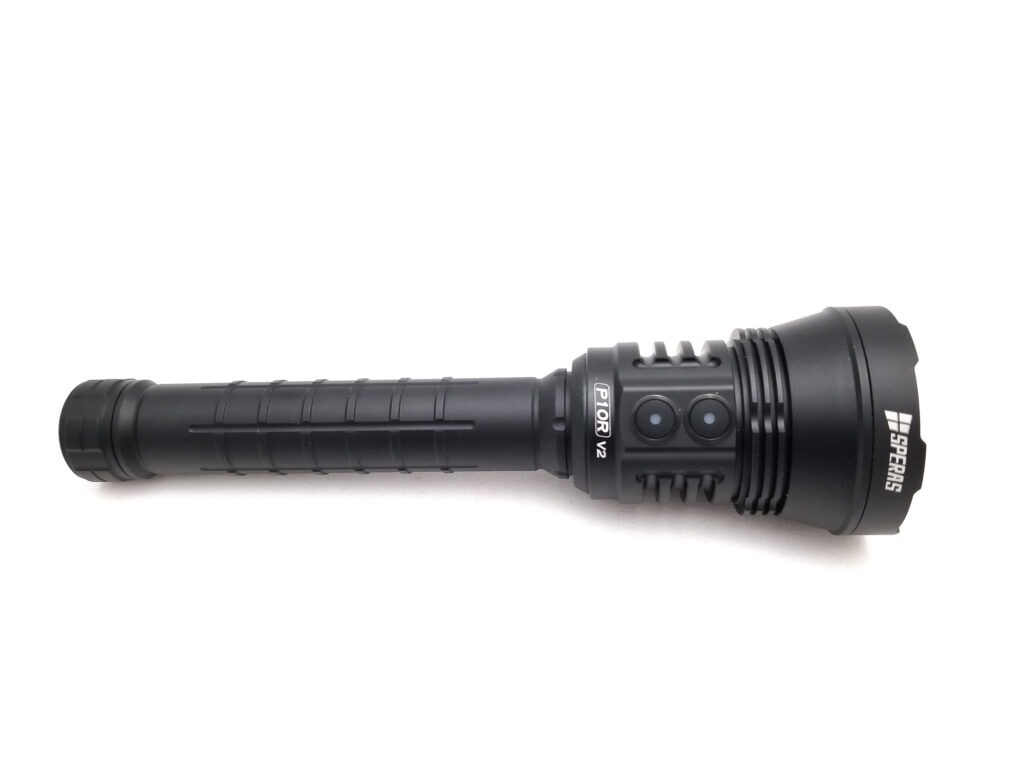
Speras P10R v2 specs
| Brand & Model | Speras P10R v2 |
|---|---|
| Flashlight category | Searchlight, General Purpose |
| LED | 3*Luminus SST70 |
| Max. output | 10,000 lumens |
| Max. beam distance | 574 meters |
| Max. beam intensity | 82,500 cd |
| Battery config. | 2*21700 Battery Pack |
| Onboard charging | USB type C |
| Modes | 5 |
| Blinkies | Strobe, S.O.S |
| Waterproof | IP68 |
| Review publication date | March 2023 |
Review intro:
Make no mistake, not too long ago, if you wanted a high-performance flashlight capable of 10,000 Lumens, your options would be limited to a small number of customized or modified offerings at wallet-lightening prices. Fast-forward to 2023, and there’s a nearly unlimited selection to choose from whether you want 30,000 Lumens or 300 Lumens, a floody triple or a 2,500 meter thrower flashlight.
Lots of manufacturers have thrown their hats into the ring, but Speras, one of the OGs of the flashlight game, is still alive and kicking. Based in Shenzen, China, they serve markets worldwide with high-end illumination tools. If you’re looking for a high-performance flashlight, they’ve probably got one for you. I’ve tested a couple of Speras light thus far, the E3 and T3R, each fulfilling very different roles. Innovation and continuous improvement is important in the highly competitive marketplace, and Speras innovates. Take their flagship P10R. Released in 2021 as a 2×21700 triple LED light featuring a dual switch user interface and 8000 Lumens. It had onboard charging and could throw 500 meters. Pretty decent specs.
There’s a new P10R now, the V2, and Speras was nice enough to send one out for testing. I love high output lights, and Speras promises some nice updates and a performance boost.
Package quality.
As a high-end light and the flagship of their catalog, the P10R V2 comes in a hard case that houses all the bits. It has dual latches and soft foam inside. It’s not going to withstand any abuse, water, etc, but it’s better than a paper box. Here’s what you get:
- Speras P10R V2
- USB A to C charging cable
- User manual
- Warranty documentation
- Speras S10T 2*21700 battery pack
- Spare o-rings
- Holster
This is a proper loadout for a working-class flashlight and includes all the accessories to get started out of the box, including a holster. There’s no lanyard, but this is predominantly going to be holstered, so I’m not too upset they didn’t include one (plus there’s nowhere to attach one anyway).
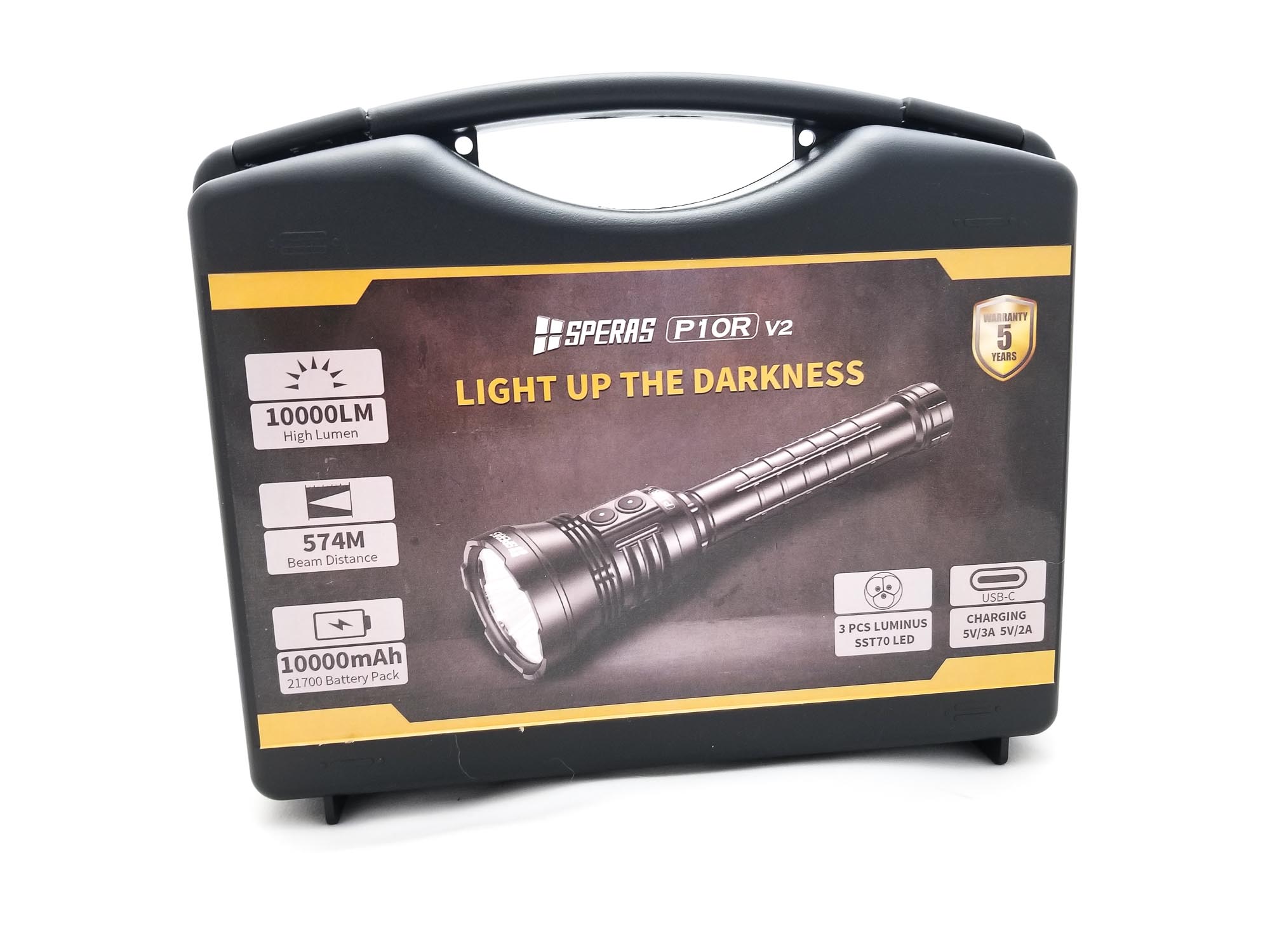
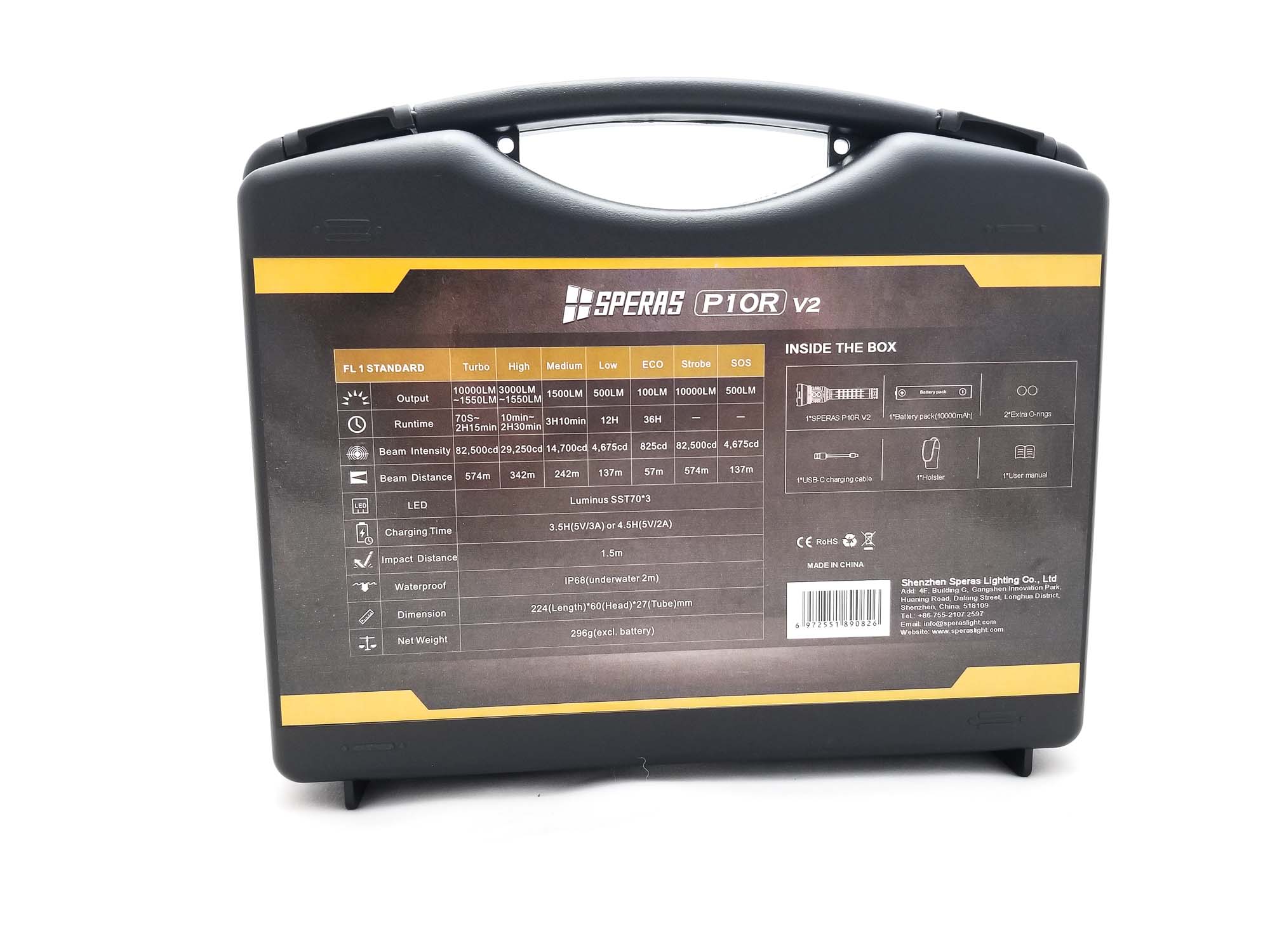
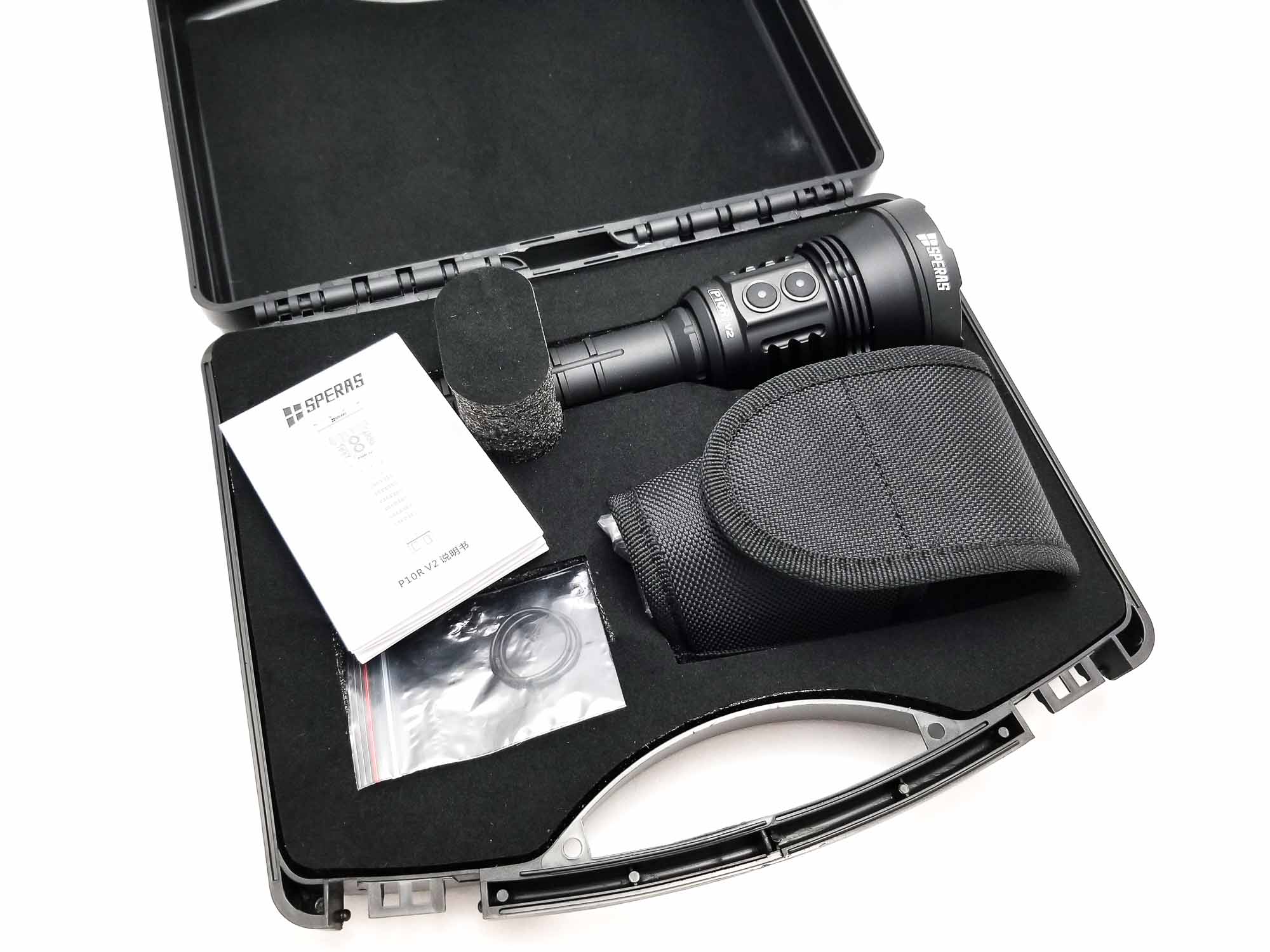
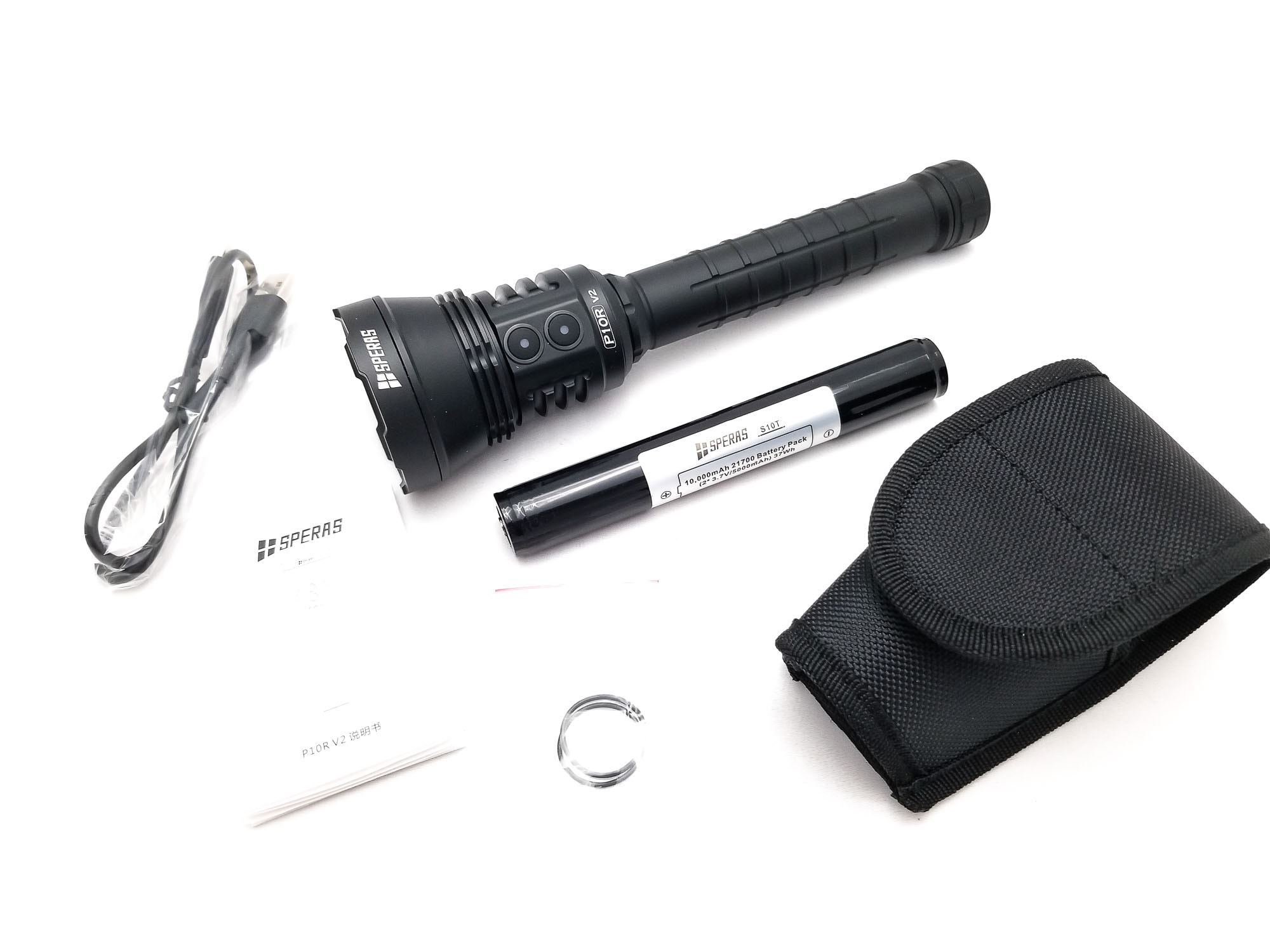
Flashlight in use
The Speras P10R V2 is a handheld searchlight, and in this role, it’s going to be what I consider to be medium range (useful to about 400 meters). You’d use this for search and rescue, surveying, or general purpose use. As always, before use, make sure to remove the battery isolator under the tailcap, otherwise the light won’t turn on.
Handling-wise, with two 21700s onboard, this is a long tube light, so it’s meant for one or two handed use. It handles like the Nitecore MH40S and Lumintop PK21 does (not surprising), and it’s overall nicely balanced. It feels really solid and high quality. The tube has circumferential and longitudinal grooves for grip. The head is designed with an elongated section behind the bezel which houses dual e-switches and the USB type C charging interface.
The controls are nicely positioned for easy access in the saber grip and overhand grip, but the switches are pretty much only accessible from the underhand position. Opposite the switches you get a charge port for the USB type C charging sealed with a silicone rubber plug. The dual switches are smartly positioned for easy access with one-handed operation and have LED indicators in the middle for charge and operation states, and are illuminated during operation.
The switches have a soft-touch cover and feel good with somewhat muted clicks, but good feedback nonetheless. Gloved hands wouldn’t have trouble with them. Speras includes a nylon belt holster, and it has a large plastic D-ring out back for hanging, and a hook and loop belt loop. A holster is just about mandatory here since the P10R is way too big for a pocket. Tail standing is at your own risk though since the light is top heavy.
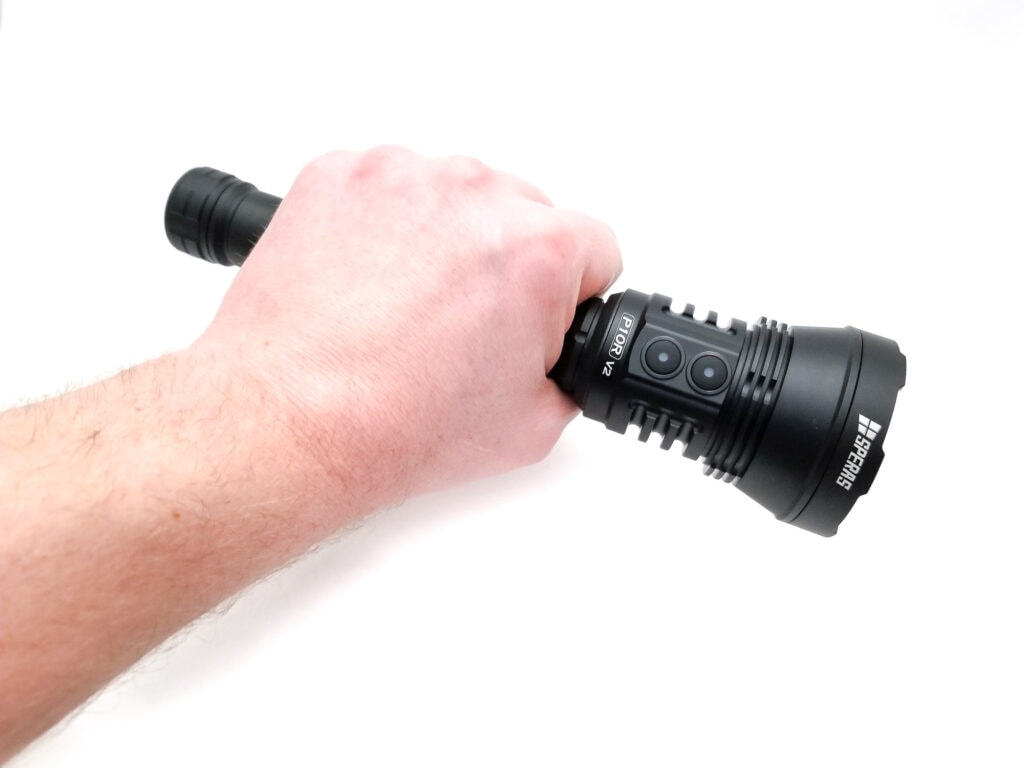
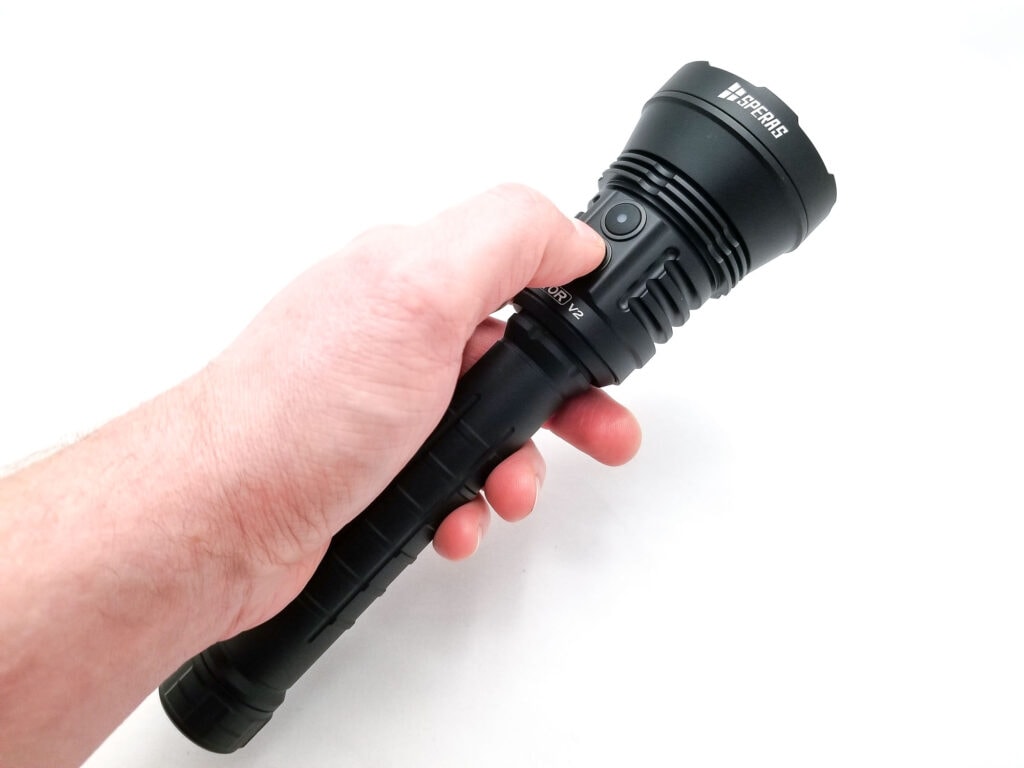
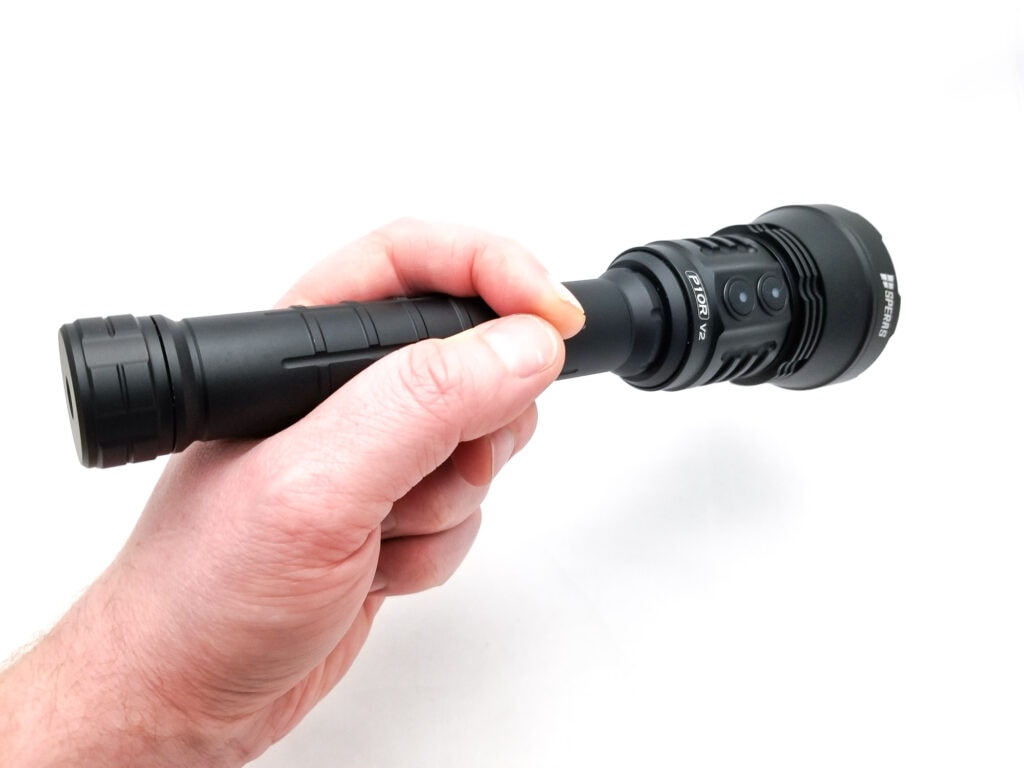
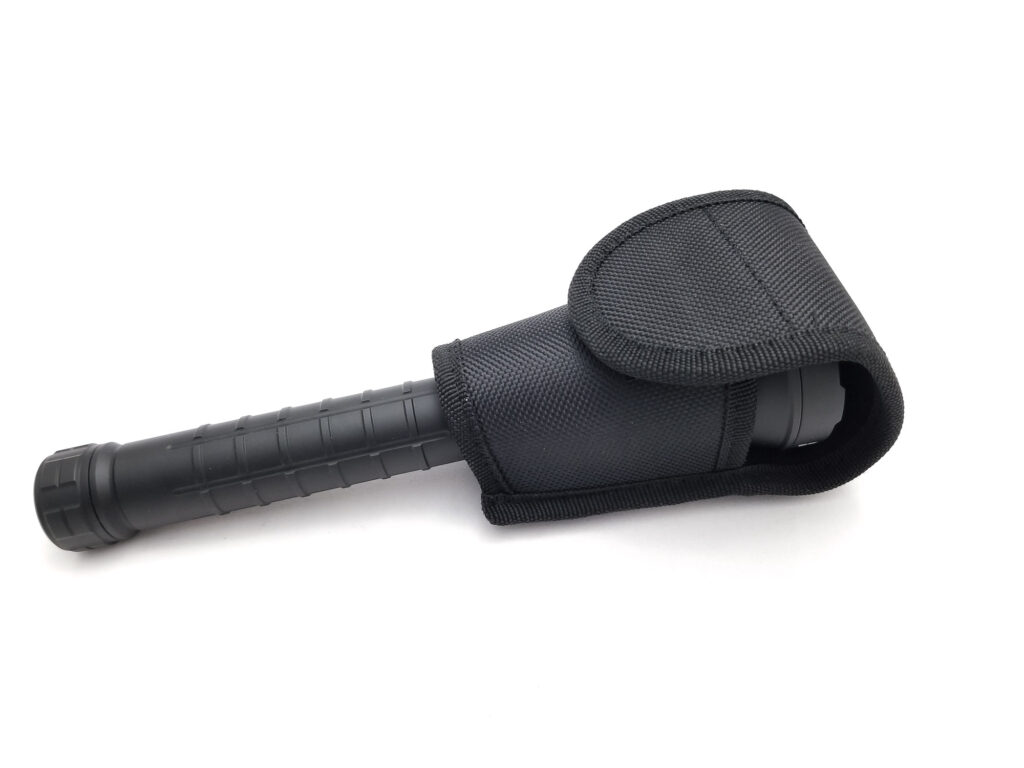
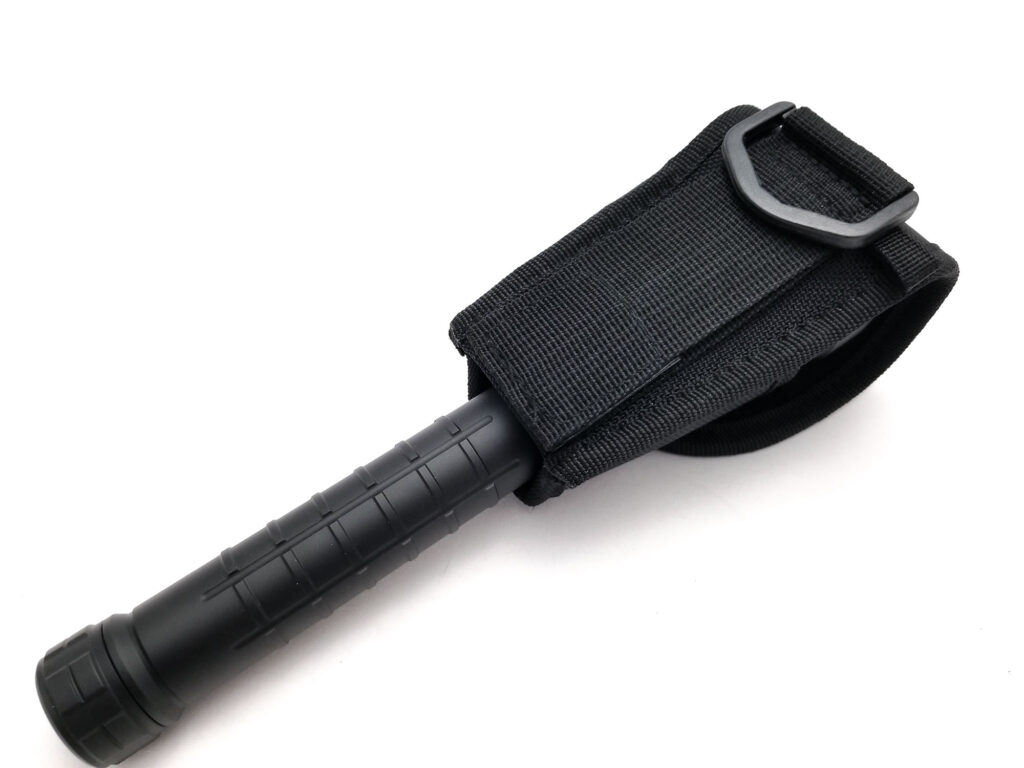
Build Quality and Warranty
It’s no secret that Speras makes high-quality lights with fit and finish on par with anything coming out of the Nitecore, Acebeam, and Olight camps. With an MSRP of around $200, it isn’t cheap, but this is a professional-grade tool, and the price of admission to the searchlight club has never been low anyways. The price isn’t so much of an issue here though and it’s competitively priced in this segment, and there aren’t many triple LED 2×21700 lights on the market so the P10R V2 is sort of an oddball.
The quality is very good as expected with very good fit, finish, and no anomalous gaps or part fitment. The light is constructed from the ever-present 6061-T6 aluminum alloy. The machining is very good and defect free with zero tool marks and chamfering everywhere for snag-free handling. There’s no misaligned parts, and the fit up is perfect with no large gaps. The finish is advertised as type III HA hard anodizing, and is a nice finish with a decently chalky texture that really contributes to grippiness. It’s flawless with no thin areas or coverage issues. There’s a single gold-plated spring in the tailcap, and a solid contact on the driver side. I was surprised by this since a spring is superior to a solid contact in a working light since it aids in durability and connection integrity. The bezel unscrews by hand, but I couldn’t get the reflector out. The threads are rectangular cut and fully anodized. They were well lubed and super smooth. There’s a single o-ring at the tail, and the bezel lens, bezel, and charge port are sealed nicely and contribute to an IP68 rating.
Speras’ warranty is comprehensive.
From Speras: 1. Within 15 days, free replacement. SPERAS will provide 15 days free replacement service of purchase for any manufacturing defects if problems come into being in normal use; We will replace it with the same model. If the model has been discontinued, customers will receive a product with similar or improved model. 2. Within Warranty time: Usually we provide 5 years warranty, some may provide lifetime limited warranty( for example E1). Within the warranty time, any defects please contact local dealer or distributor for warranty support. We will repair or we replace a new product for you according the defects. 3. The free warranty does not cover any damages or failure caused by: a. Normal wear, b. Rough operation, c. Battery leakage
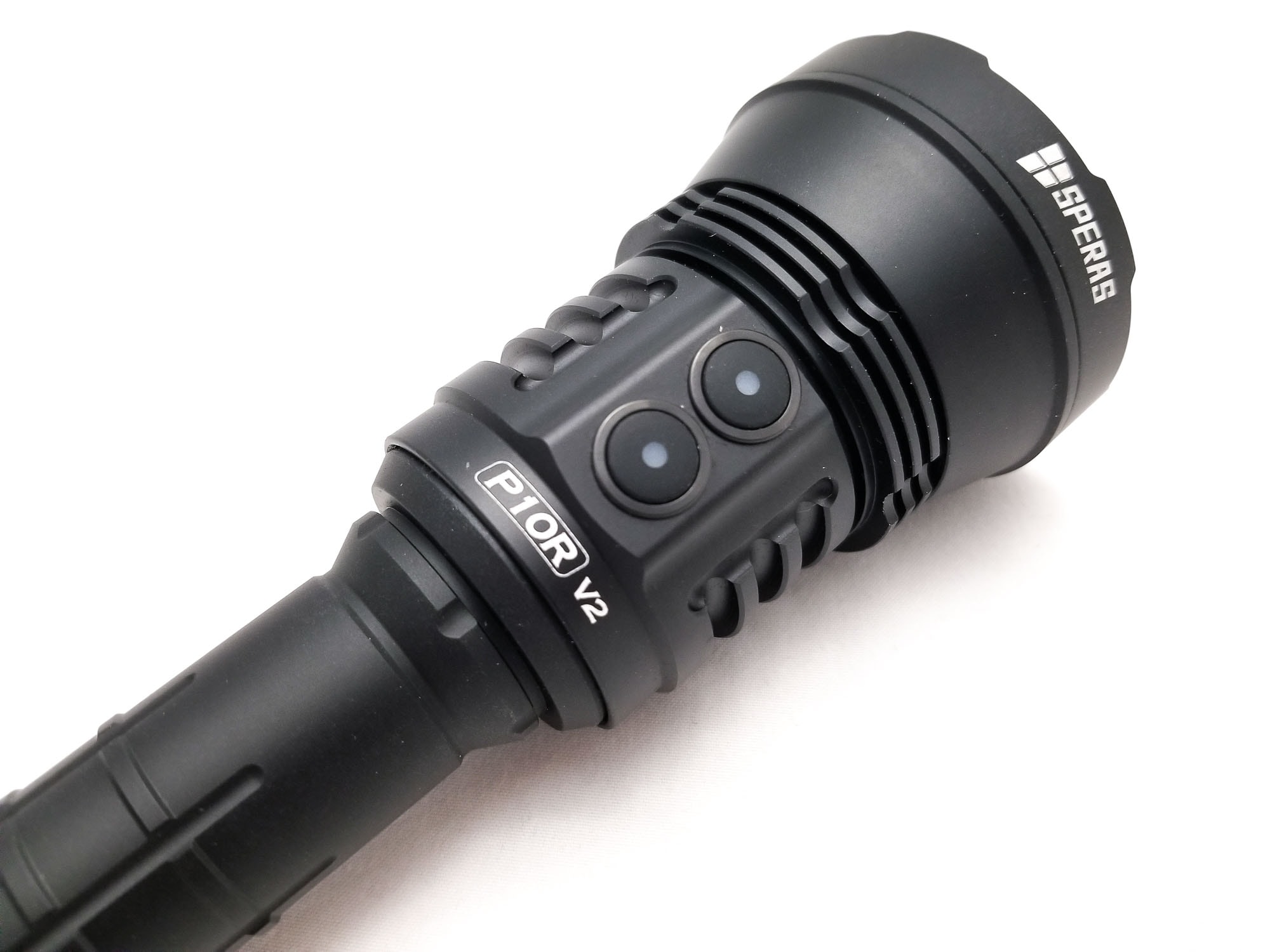
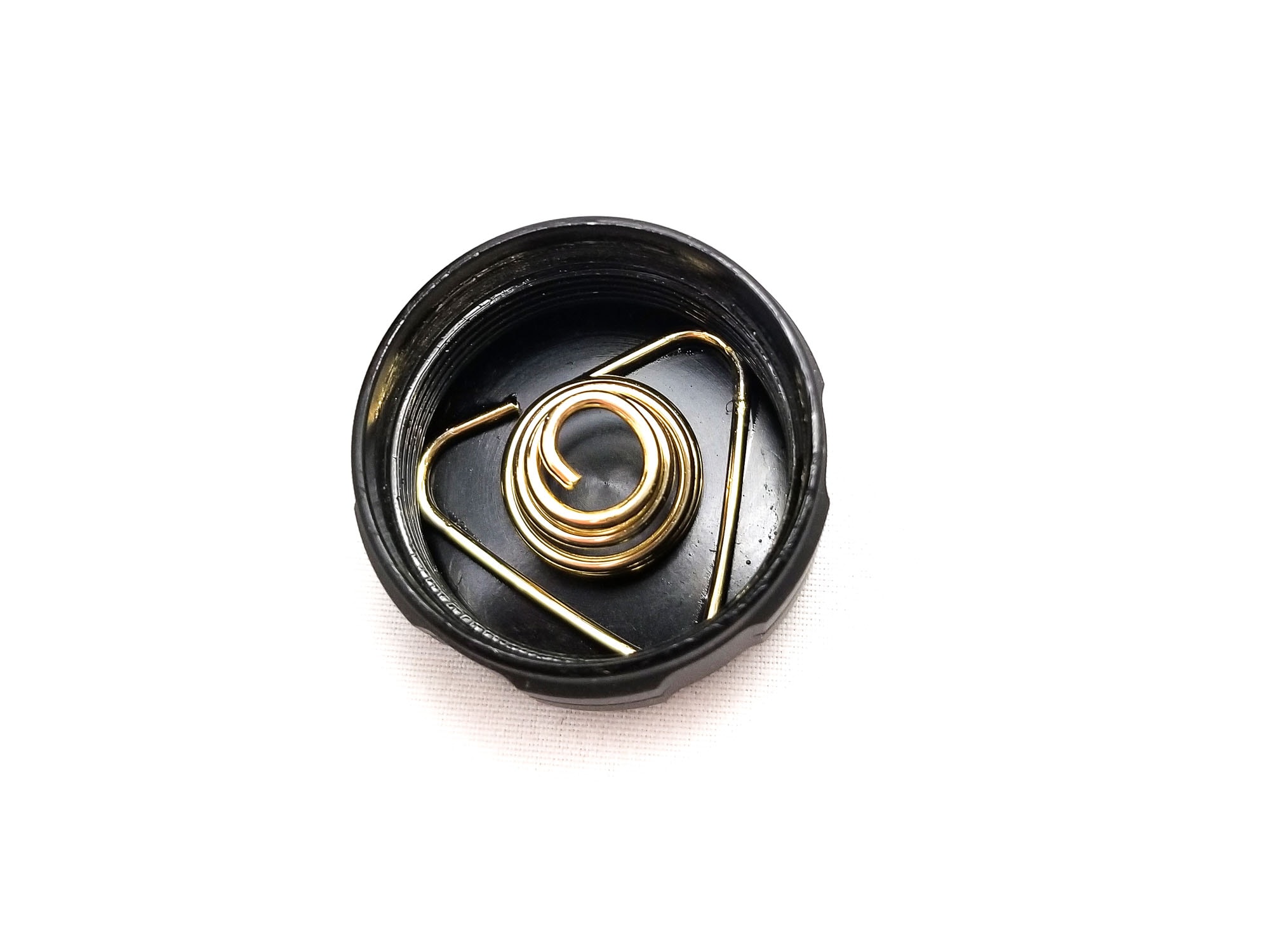
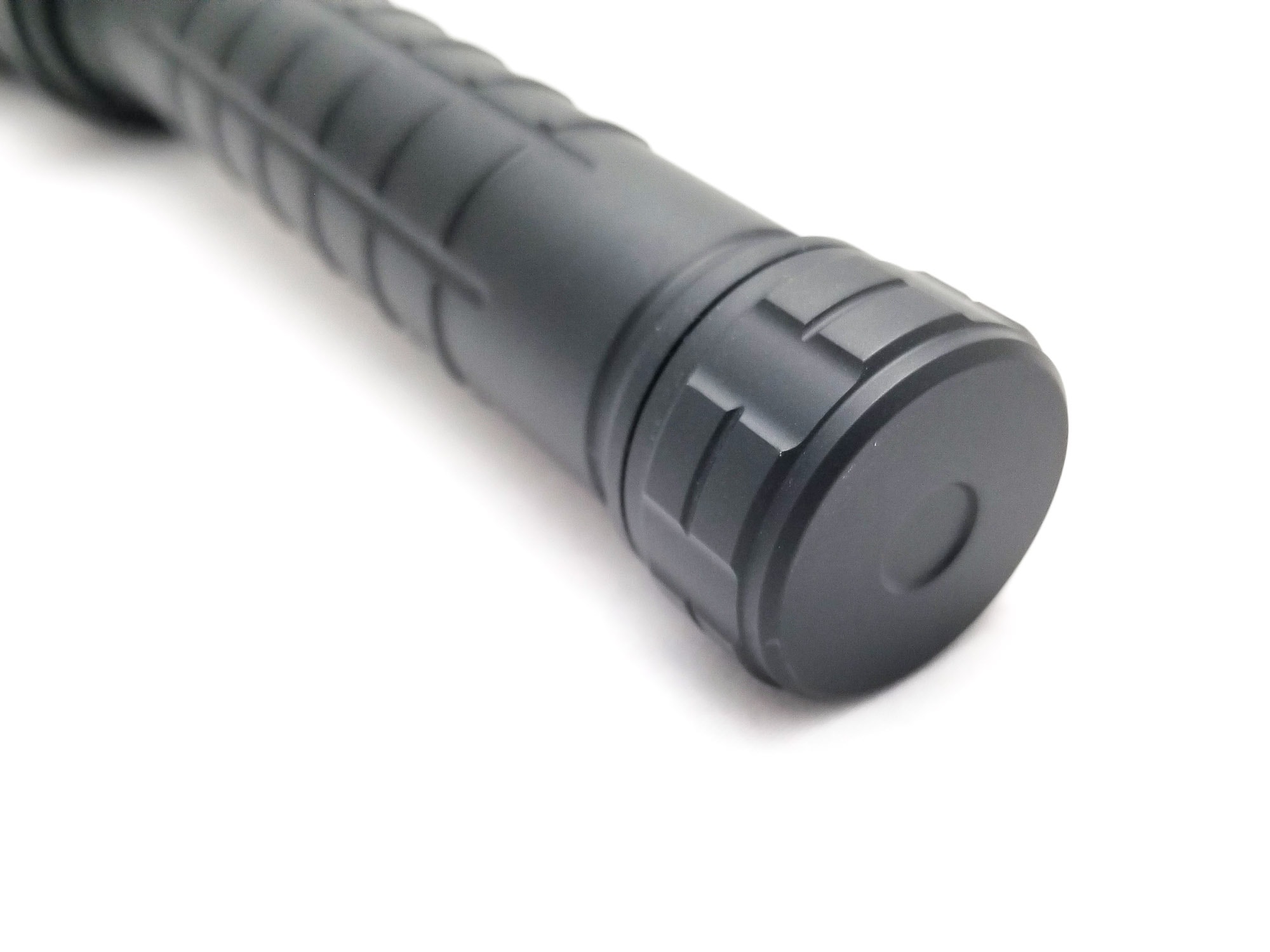
LED, Lens, Bezel, Beam, and Reflector
The P10R V2 adopts the same triple LED configuration as the previous P10R, and Speras doesn’t make us guess which LEDs they’ve installed, and keen-eyed readers will instantly recognize the Luminus SST70 LED. This also means that the LEDs are unchanged from the prior generation. This is a familiar face in the tactical light category for good reason. It’s a quad die domed LED, and borrows the dies from the SST20, bond wires, and all. It’s a 5050 size package, same as the XHP50 series, and runs on 6 volts. The higher vF requires a boost driver or a buck driver with series cells, though, with the benefit being laminar, fully regulated output. The quad SST20 dies make for very high output comparable to the XHP50.2, but with an ever-so-slightly smaller LES, you’re getting a bit more throw.
Since the die isn’t completely bathed in phosphor, you won’t get any chromatic aberrations or tint shift. The tint isn’t specified, but it’s obviously cool white. One of the biggest gripes I have with the SS-series LEDs is the green tint at low output in the CW CCTs. How green depends on how you do on the bin lottery, but generally folks who buy this light probably won’t care though so it’s a moot point. On Turbo at 2 meters from the sensor, the Opple Lightmaster Pro has the tint coming in at 6202K and 65.5 Ra. The Duv is 0.0093, so a bit less green, but still noticeable at lower output.
The triple reflector is a roughly 55 mm diameter OP unit (to help smooth out the iffy beam profile). It’s covered by a hardened mineral glass dual-AR coated lens. The bezel is blacked out aluminum and isn’t glued on (surprisingly). The bezel is crenulated and extends about 4 mm over the lens to protect it. The beam is nice and about perfect for a multi-LED setup. There’s a lot of bight spill for excellent side illumination, and you get a large, but diffused hotspot with very good beam distance for visibility out to 300 meters. The beam is pretty clean also without a lot of artifacts, but there’s still some due to the triple reflector..
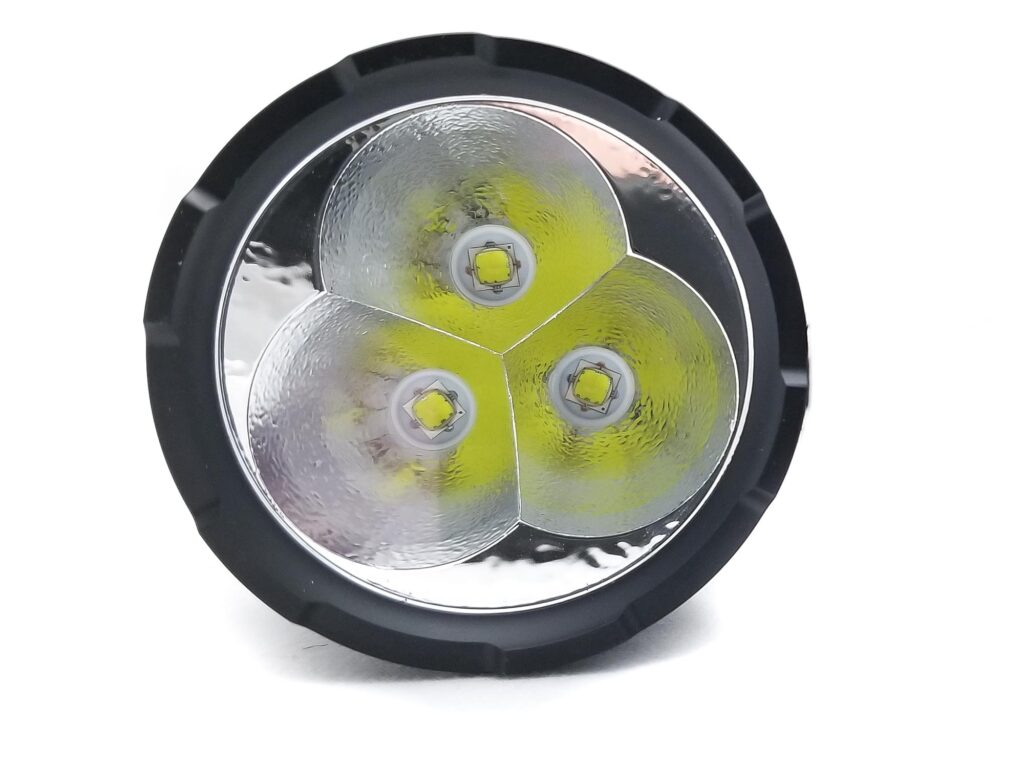
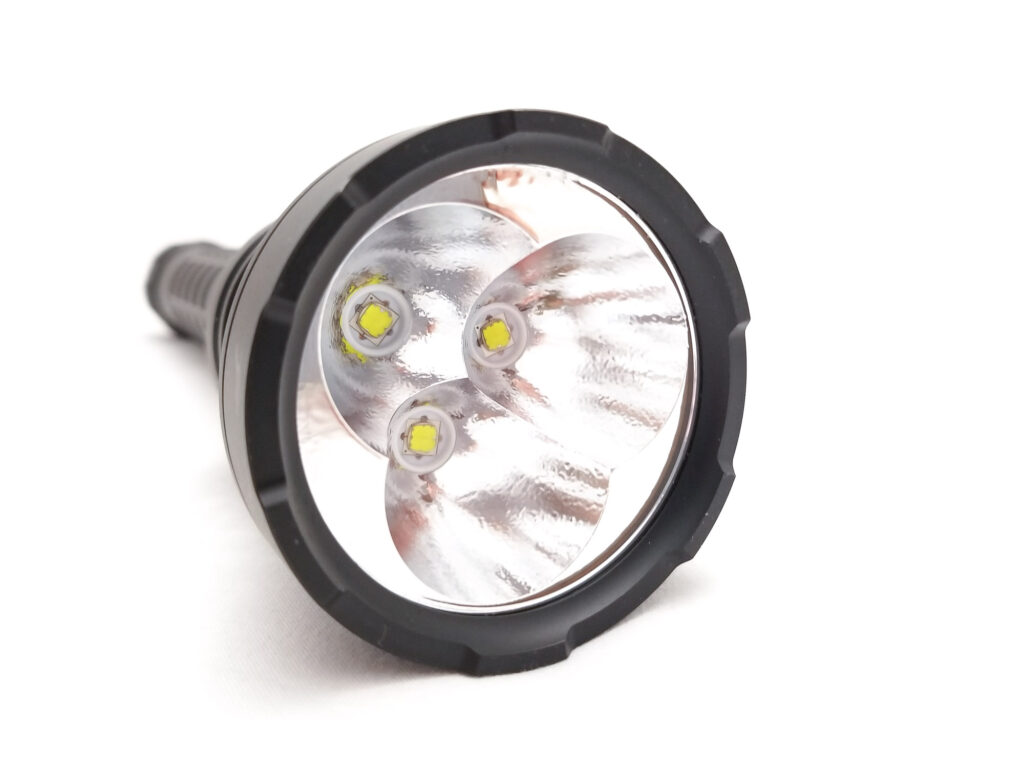
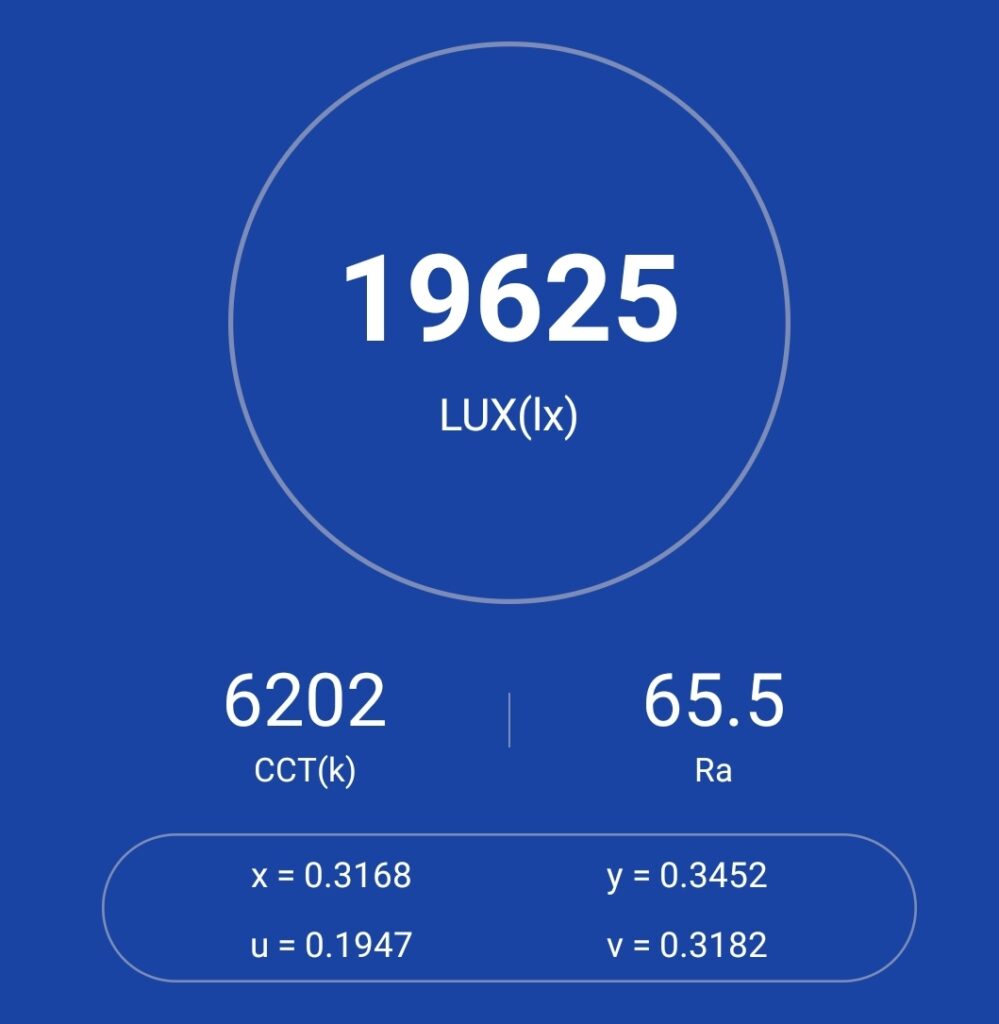
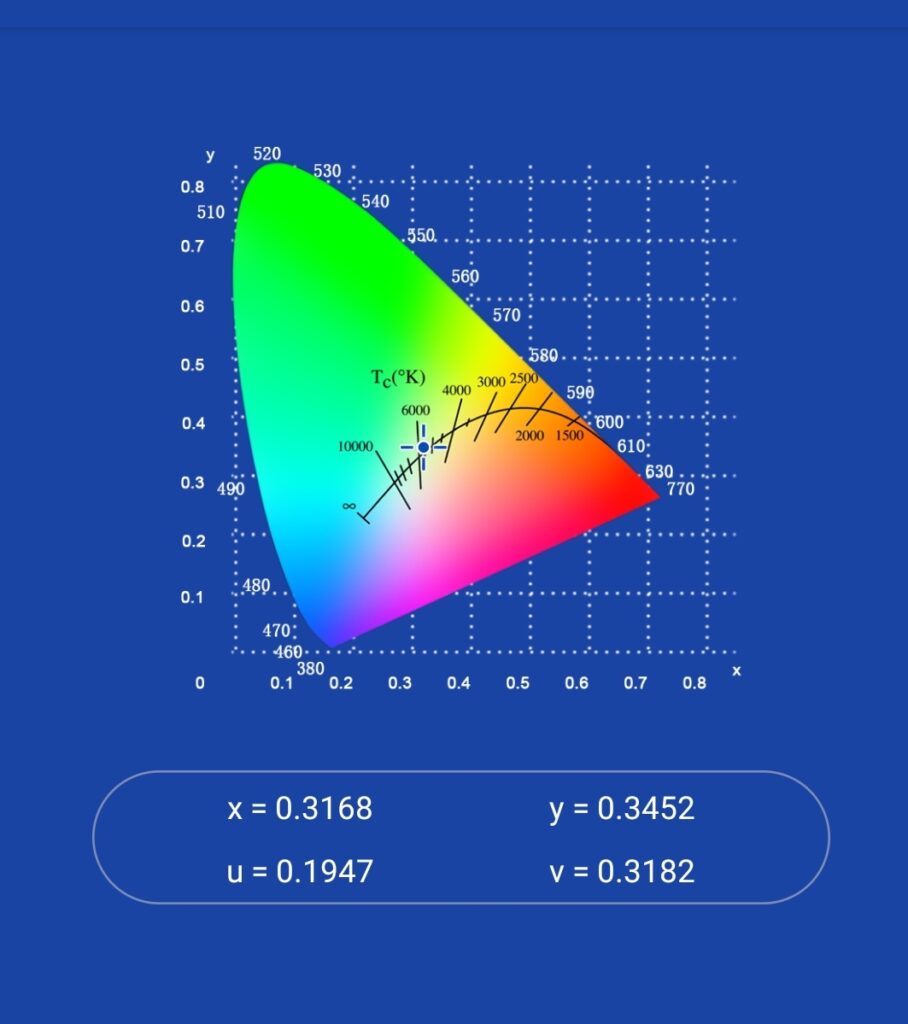
Dimensions and its competition
Dimensions:
| Dimension | Millimeters | Inches |
|---|---|---|
| Length | 244 mm | 8.8 in |
| Body diameter | 27 mm | 1.0 in |
| Head diameter | 60 mm | 2.3 in |
Dimensions are rounded to the nearest millimeter, and to the nearest tenth of an Inch.
Weight:
| Weight | Grams | Oz. |
|---|---|---|
| With included battery | 453 g | 15.9 oz. |
| Without battery | 307 g | 10.8oz. |
Weight is rounded to the nearest gram, and to the nearest tenth of an Oz.
Flashlight size comparison with its competition
Group 1 with 2×21700 lights left to right: Nightwatch NS59v1, Speras P10R v2, Nitecore MH40S, Lumintop PK21
Group 2 left to right: Thorfire C8, Speras P10R V2, Acebeam P18 Defender, Cyansky K3 v2
Group 3 triple LED lights reflectors left to right: Speras P10R V2, Astrolux EC03, Imalent R30C
Group 4 beam and tint comparison left to right: Speras P10R V2, Astrolux EC03 (3x SST40 5000K), Imalent R30C (3xSST70). We can see the tint difference between the greener SST70 vs the more neutral SST40.
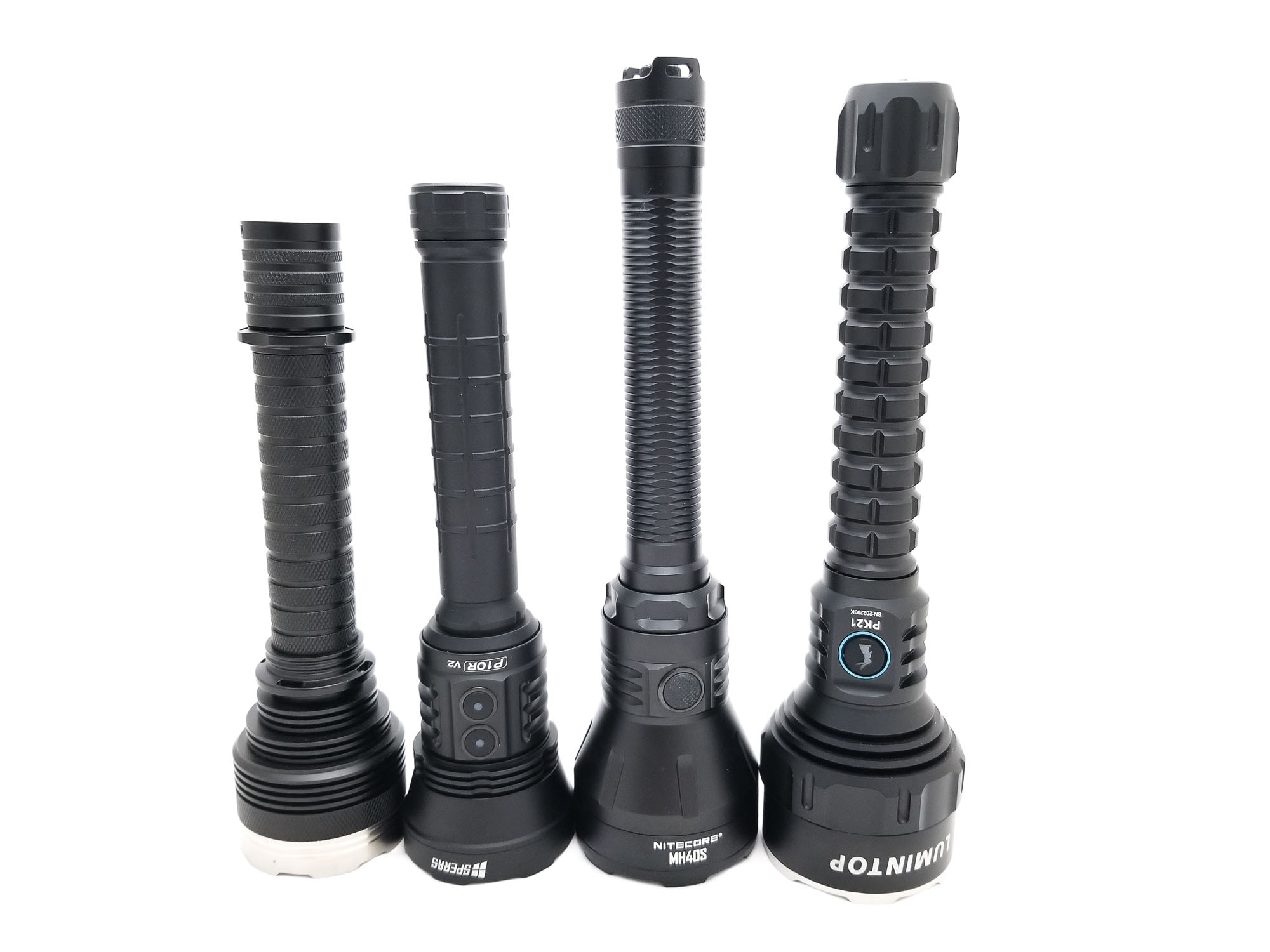
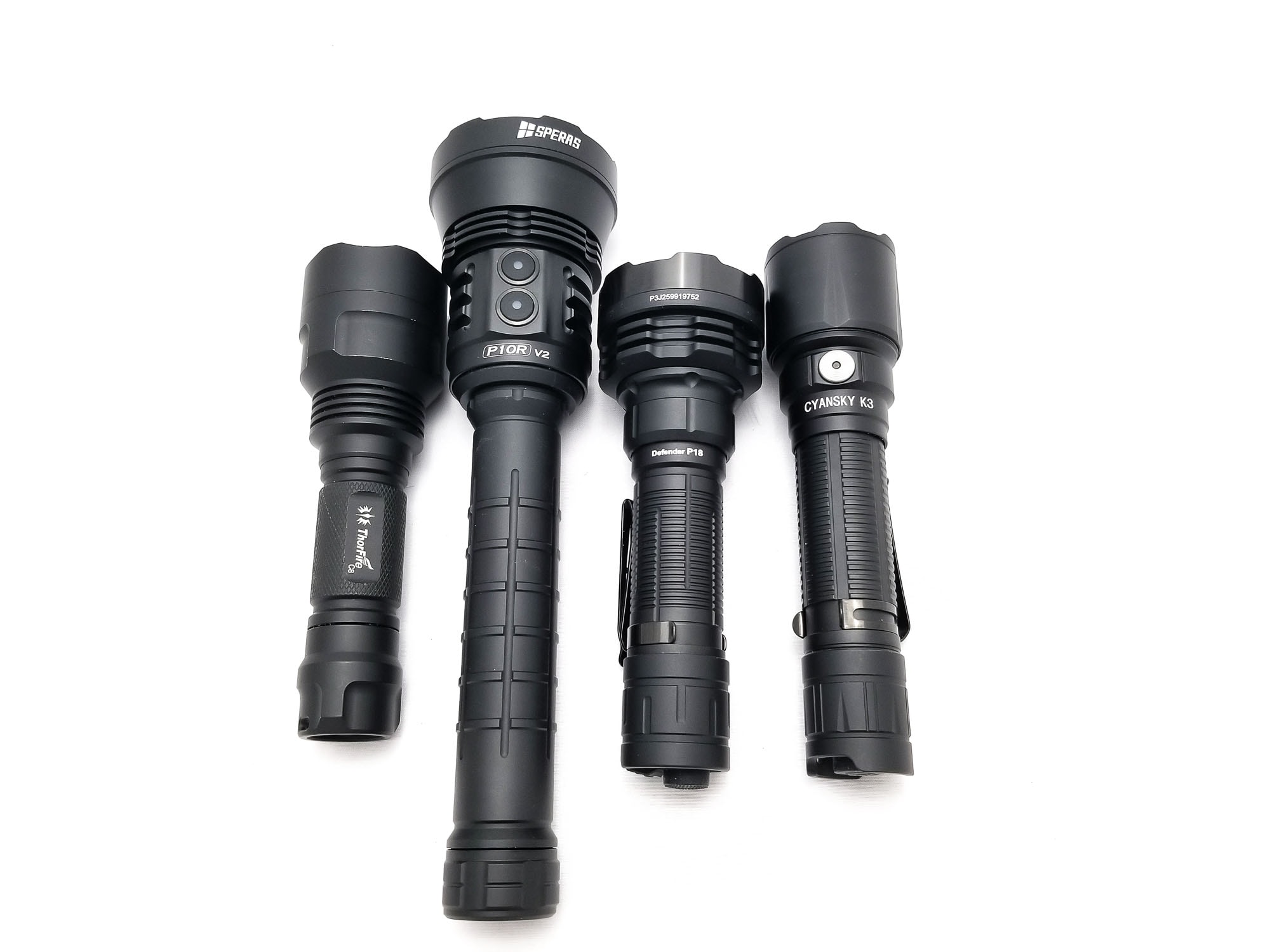
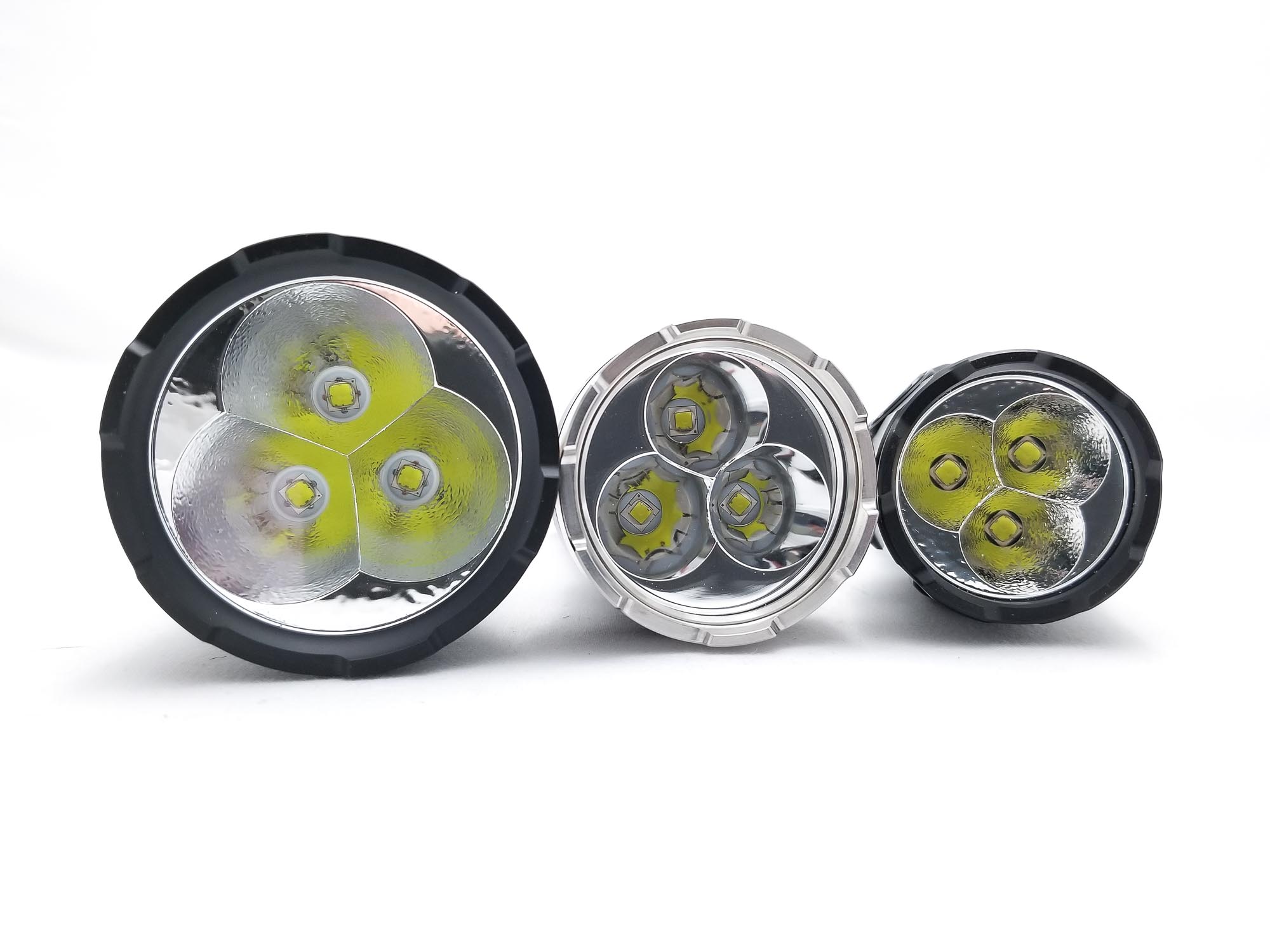
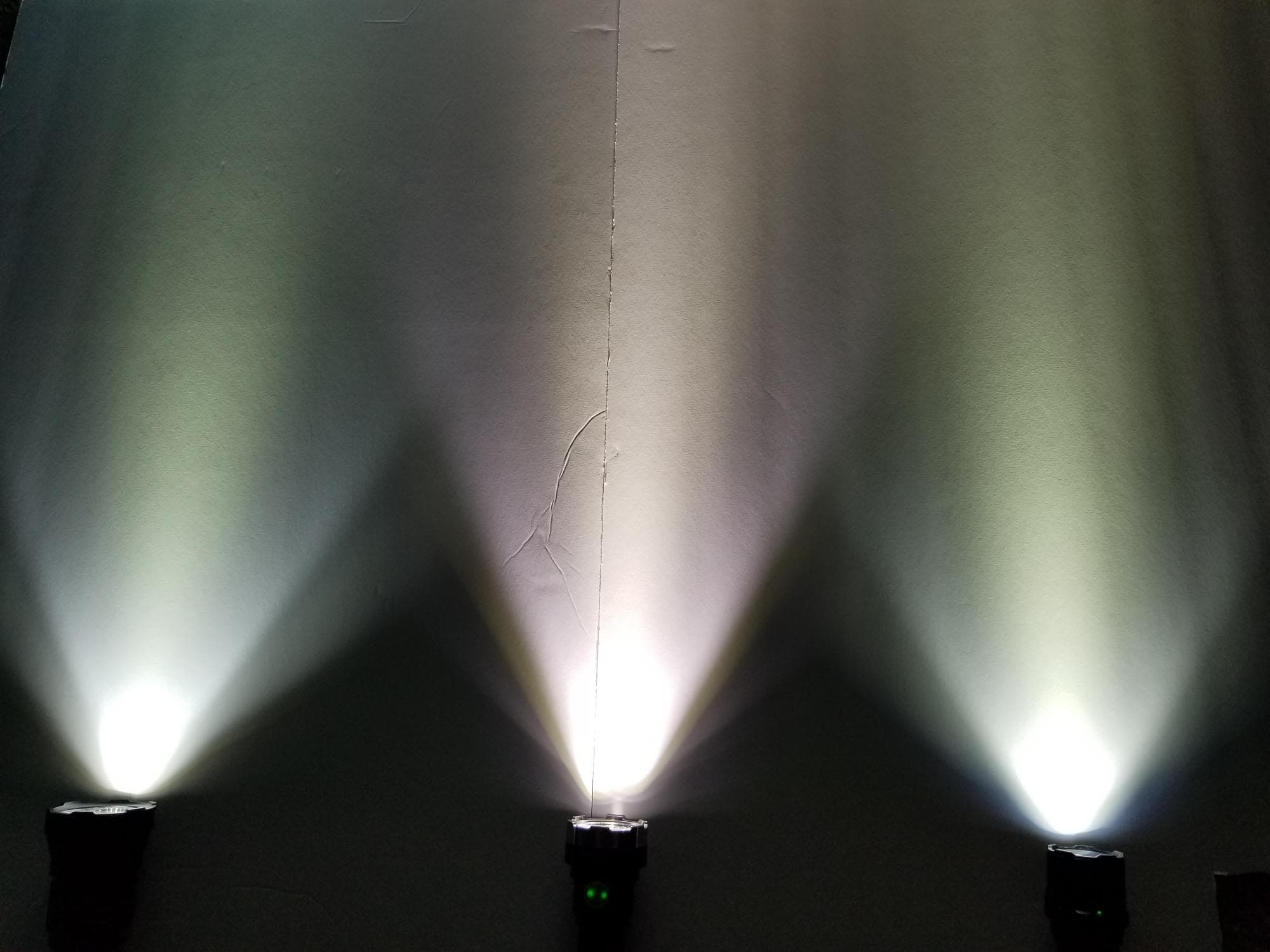
Speras P10R v2 UI: User Interface and Driver
For the driver, the P10R V2 is driving the SST70. This is a 6 volt LED and requires series cells or a boost driver, and since the P10R V2 uses two 21700 batteries, we’re probably dealing with a buck driver. These are constant-output drivers with great, laminar output for continuous output that doesn’t track with the battery voltage sag. This is a very important feature for lights going into the field for pro use.
The UI is tuned to work with the dual switches and it’s nicely done! The topmost button (Assistance Top Button, per Speras) controls instant access to Turbo mode, Strobe, and SOS, while the bottom button (the Main Button), controls the 4 regular modes + Turbo.
Available Modes:
Eco, Low, Low, Medium, High, Turbo,
Special modes:
- Strobe, SOS
From OFF:
- Press and hold top switch: Momentary on in Turbo
- Double click top switch: Strobe. Click again for SOS. Clicking again reverts back to the last used mode from the main mode group
- Single click bottom switch: Turns on in last mode
- Long press bottom switch: Eco mode
From ON:
- Press and hold top switch: Turbo. When in Turbo, clicking the top switch again switches to Strobe, and clicking again switches to SOS
- Long press bottom switch: Turns off
- Single click bottom switch: Switches modes Eco-Low-Med-High-Turbo
Mode memory:
- Yes, last mode memory. Turbo mode is memorized. Blinky modes are not.
Low voltage warning:
- The battery has a protection circuit for LVP, and the switch LEDs show the battery state:
- Green 100% to 70%,
- orange 70% to 30%,
- red 30% to 10%,
- flashing red 10% to 1%.
Strobe/blinkies
- SOS and variable Strobe. When in Turbo, clicking the top switch again switches to Strobe, and clicking again switches to SOS
Lock-out mode:
- None. Unscrew the tailcap ⅛ turn to lock out
Shortcuts:
- Long press bottom switch from off for Eco mode. Long press top switch for Turbo.
PWM
- None visible
Additional info: This is a nice UI! It works great with the dual switches, and I appreciate Speras use of the two switches to separate the more ‘tactical’ functions (instant Turbo, shortcuts to the blinkies), while maintaining the Turbo mode and an Eco mode as part of the regular mode group, controlled by the bottom switch.
The fact that Turbo is memorized and can be called up with a single click is very nice, and would be useful in many situations. I like that Eco mode can also be called up with a single click. The mode spacing makes sense as well, even if Eco isn’t really very low at 100 Lumens. ATR is present as well, and since we’re dealing with a lot of power, it will be interesting to see how Speras executed that since I’m expecting to see excellent thermal management.
Speras P10R v2 Charging and batteries
Speras has taken the common route for power with the P10R V2 and gone with a battery pack instead of loose cells. Many professional use lights are now using either proprietary batteries or battery packs, so I’m not super surprised to see one here. The P10R V2 battery pack is made up of two, 21700 li-ion batteries for power arranged in series for a total voltage of 8.4 volts. They’ve gone with 5000 mAh batteries, so the total capacity should be 5000 mAh, but Speras advertises it as 10,000 mAh. Hmmm. Usually, you’d need parallel batteries to double the capacity, not series. This battery pack is going to have a built-in BMS and protection board to keep those batteries healthy and living a long time (and to keep from going critical if abused)..
There’s onboard charging as well of the USB type C variety. Speras advertises it as either 5 volt 2 amp, or 5 volt 3 amp. In my testing, using a PD power brick, I got around 5 volts 1.7 amps on a completely depleted battery pack. I haven’t seen the 3 amp charge rate yet. USB type A to C and C to C yielded the same results on both the Ruideng AT35 USB tester and C to C tester. The battery was charged in about 3 hours.
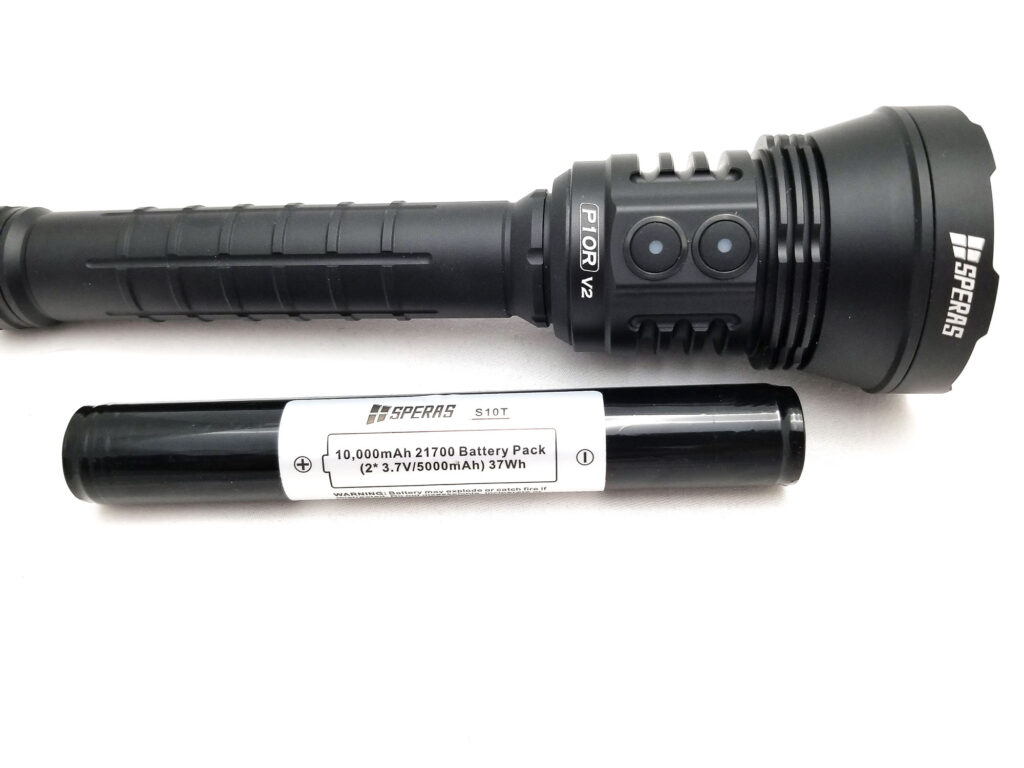
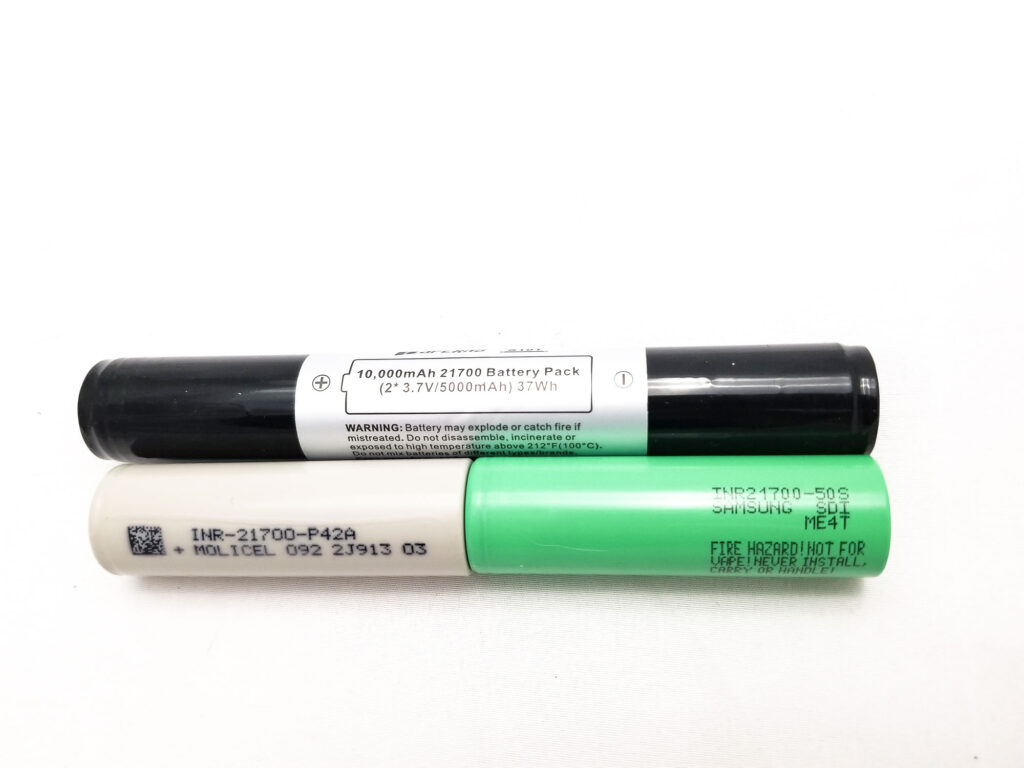
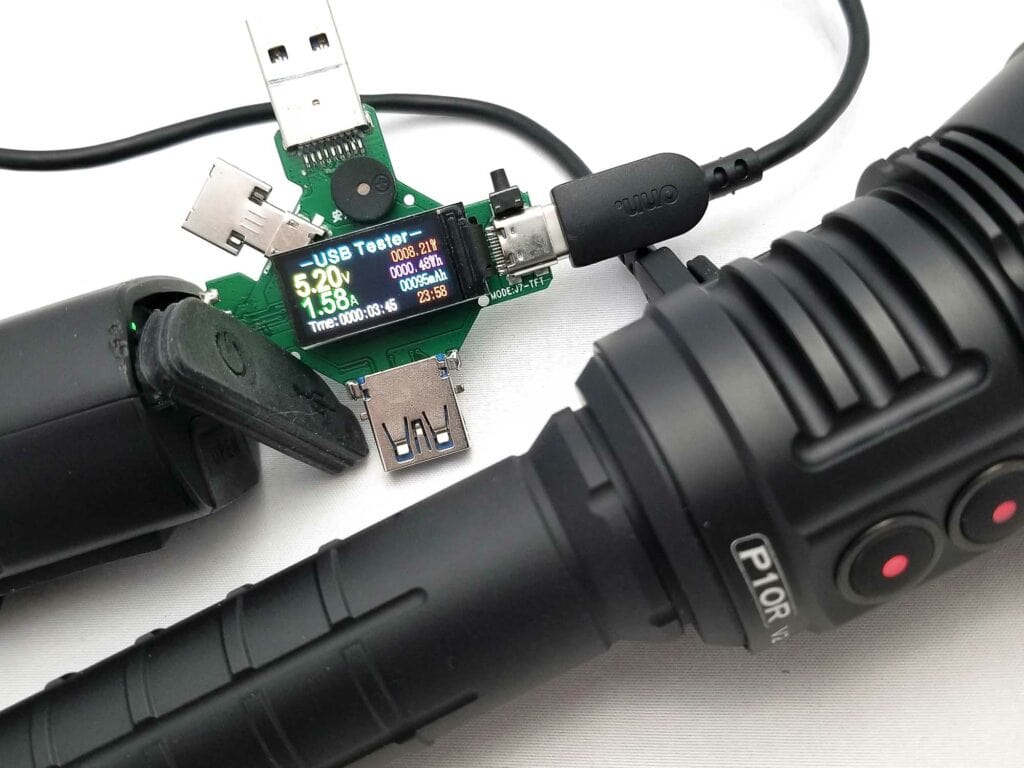
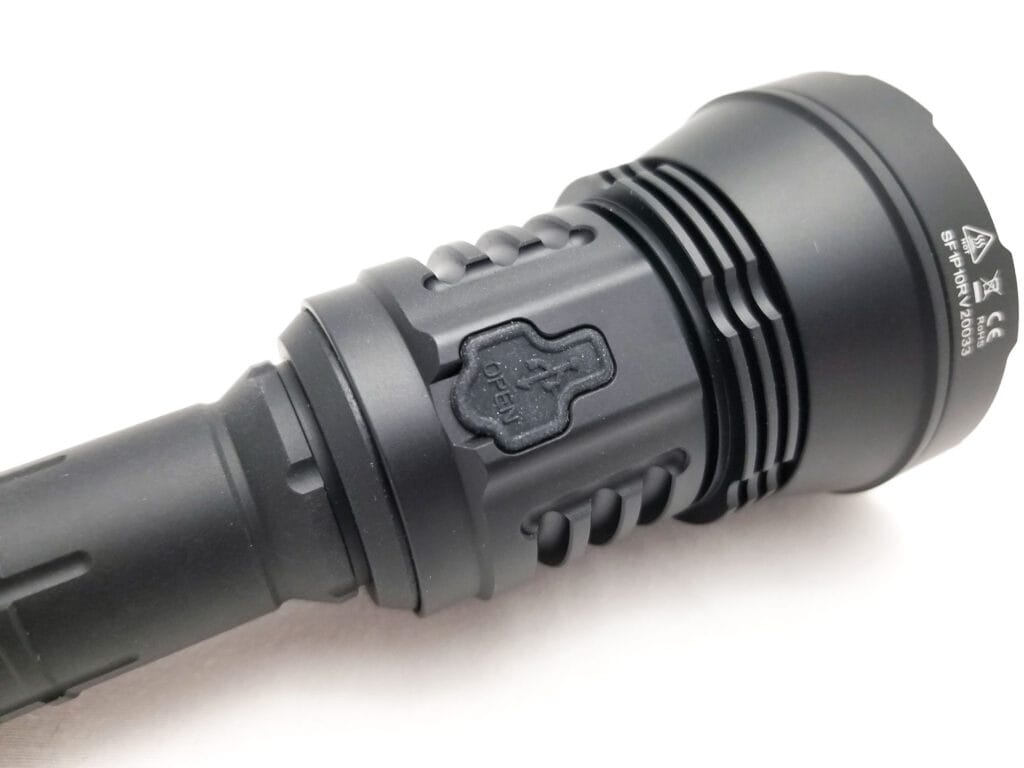
Performance test
Lumen measurements
Lumens are measured in my 50 cm integrating sphere with a Digi-Sense 20250-00 data logging luxmeter. The sphere has been calibrated with a Convoy S2+ measured to 260 Lumens and the figures are within 10% of actual. I used the included S10T 5000 mAh battery pack and tested Medium, High, and Turbo modes. Current measurements taken with my Thsinde 18B+ multimeter with 14 gauge wires in the meter and my FY19 clamp meter for current over 3 amps with a 12 gauge wire in a loop. All measurements taken at 30 seconds.
| Mode | Amps | Specs | turn on | 30 sec | 10 minutes |
|---|---|---|---|---|---|
| Eco | 150 mA | 100 | 101 lm | 101 lm | – |
| Low | 490 mA | 500 | 492 lm | 492 lm | – |
| Medium | 1.48 A | 1500 | 1525v | 1513 lm | 1488 lm |
| High | 3.28 A | 3000 | 3050 lm | 3050 lm | 2878 lm |
| Turbo | 16.10 A | 10,000 | 8610 lm | 8241 lm | 1476 lm |
Here we see the somewhat low input current for three, high power LEDs at full power. A 3 volt LED would be pulling in excess of 30 amps on Turbo. The Turbo spec is 10,000, and I’m getting less than that, but the other figures look good, so we can see Spera’s numbers are pretty trustworthy and what I expect from a $200 flashlight.
Parasitic drain:
- .05 mA nice and low
Speras S10T battery life: Runtime graphs
Runtimes are measured in my 50 cm integrating sphere with a Digi-Sense 20250-00 data logging luxmeter. The sphere has been calibrated with a Convoy S2+ measured to 260 Lumens and the figures are within 10% of actual. I used the included fully charged Speras S10T 5000 mAh battery pack and tested Medium, High, and Turbo modes.
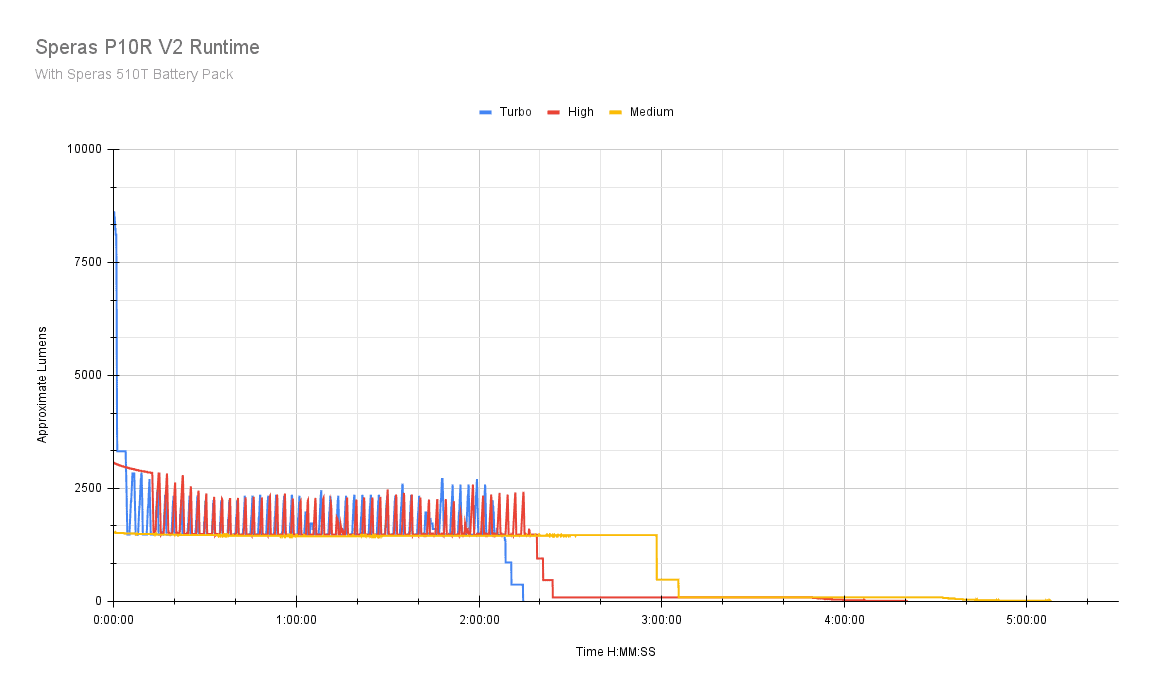
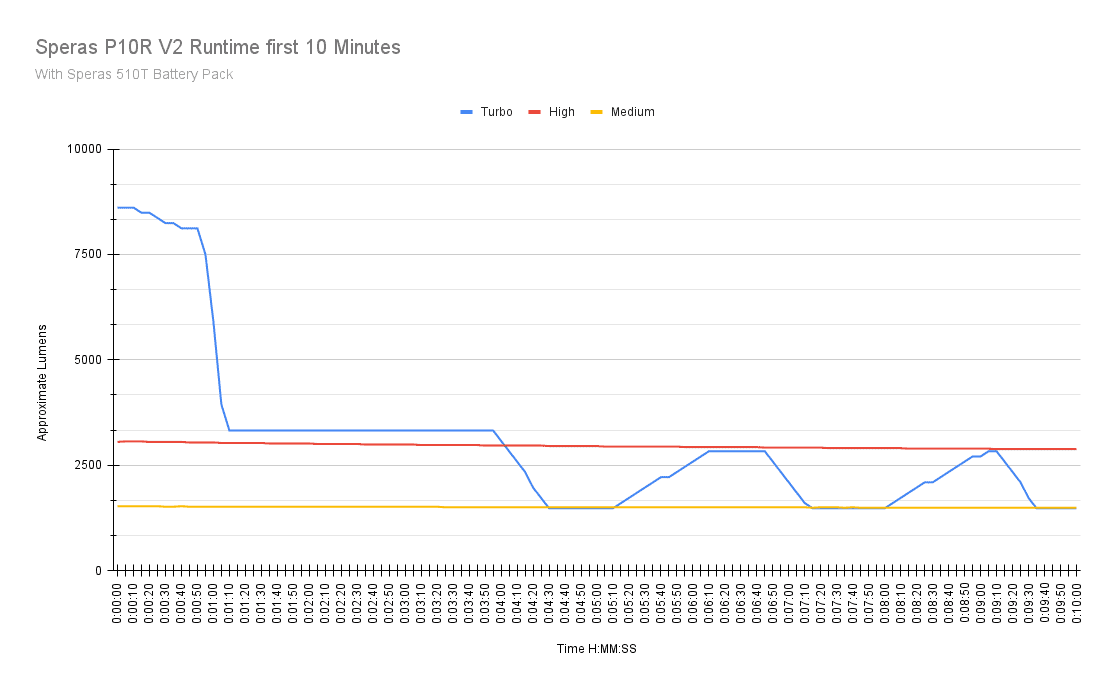
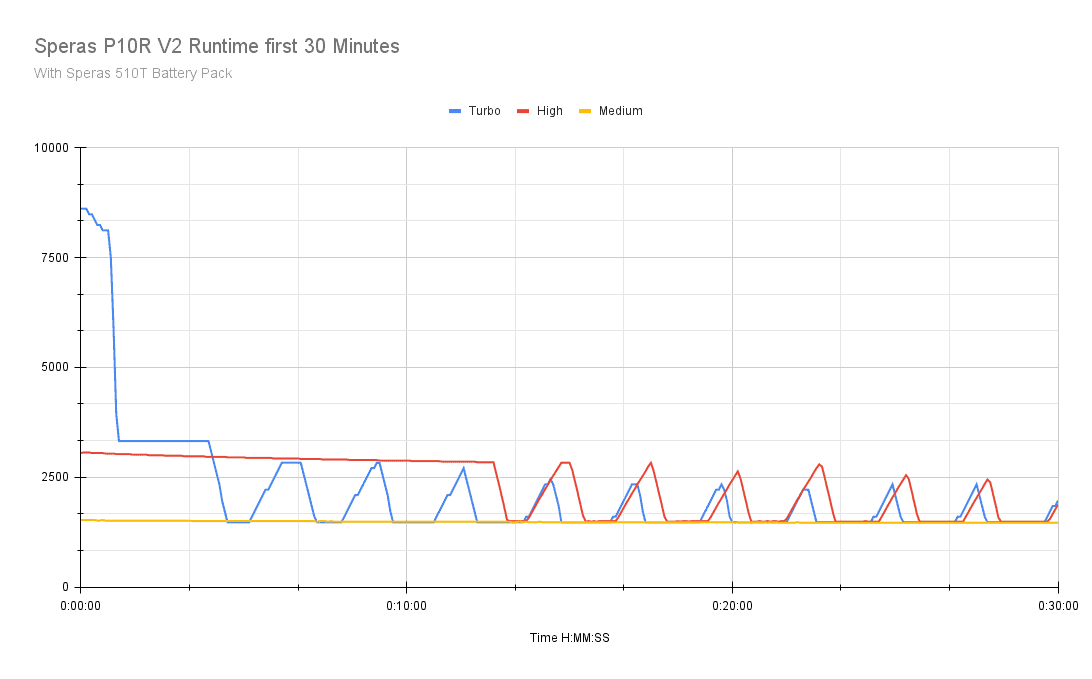
| Mode | Specified | Measured runtime (ANSI) | Time till shut off |
|---|---|---|---|
| Medium | 3h 10m | 3h 5m | 5h 7m |
| High | 2h 40m | 2h 24m | 4h 20m |
| Turbo* | 2h 16m 10s | 2h 8m | 2h 14m |
Once again, we see Speras figures are spot-on for the ANSI runtime when accounting for variables in batteries, etc. The output for these modes, thanks to the buck driver, is also mostly laminar and has great sustained output. However, I say mostly because Speras hadn’t eliminated the sawtooth thermal regulation I observed on the E3. On Turbo it started at about the 4 minute mark, and at 12 minutes for High mode, with fluctuations of about 1100 Lumens lasting for around 2 hours 15 minutes for each mode. This is something I’m used to seeing on cheaper lights, not on pro-level lights, and while it’s not too bad, it is noticeable in use, with the fluctuations being visible in the sphere and if you pay really, really close attention out in the field.
Otherwise, it does a good job keeping the P10R V2 hand friendly and the 90 watts output thermally friendly. I never saw over 55 C, and it didn’t heat up too fast for a powerful light: On Turbo from 20 C ambient it hit 54 C in about 60 seconds, and on High it took 10 minutes to hit the same ceiling. Once the light hits LVP, the output drops low to about 90 Lumens for each mode, but you still have useful amounts of light for another 45 minutes or so before it gets really dim. Overall this is good performance, all things considered. Since there’s a BMS in the battery pack, LVP will absolutely pull the plug when the cell says ‘enough’ and drops the output to 0 volts. The light was useless after each test due to this, so make sure you watch the switch LED for the blinking red light.
ANSI FL1 standards: The runtime is measured until the light drops to 10% of its initial output (30 seconds after turning on). This does not mean that the flashlight is not usable anymore. The last column shows how long the light actually works till it shuts off. If there is a + symbol, it means that the test was stopped at that particular point, but the light was actually still running. This happens on certain occasions, with certain drivers, firmware, or batteries.
Peak beam intensity and beam distance measurements
Beam distances are measured using a Uni-T UT383S luxmeter measured indoors at 5 meters using the included fully charged S10T 5000 mAh battery pack. Measurements taken at 30 seconds.
| Mode | Specified | Candela measured | Meters | Yards |
|---|---|---|---|---|
| Eco | 825 cd | 1000 | 57 | 62.7 |
| Low | 4675 cd | 5425 | 147 | 161 |
| Medium | 14,700 cd | 15,225 | 247 | 270 |
| High | 29,250 cd | 31,975 | 358 | 391 |
| Turbo | 82,500 cd | 92,675 cd | 609 | 666 |
I’m beating Spera’s numbers slightly here, and for a small-ish head triple, these are good numbers, beating the throw figures on the Astrolux EC03 with triple SST40s in SMO reflectors. Even on High mode, we’re seeing over 300 meters of throw, which is more than enough for all but the most specialized duties (in which case you’d grab a dedicated thrower) and it will be sustainable for a long time. Even Turbo, at 600 meters (Speras advertises 574) is sustainable for over 30 seconds.
Peak Beam info: Peak beam distance according to ANSI FL1 standards: The calculated value of distance in meters at which the flashlight produces a light intensity of 0.25 lux. (0.25 lux is about the brightness of a full moon shining on an object). Columns Meters and Yards show rounded numbers.
Beamshots
I compared the P10R V2 to some other single and multi LED high output flashlights. Photos taken with my Samsung Note 8. The 95 meter shots with the camera set to 0.3s ISO 200 and 5000K WB. The fence is 95 meters away. The trees in the background are between 200 and 300 meters distant, and we can see them on Turbo mode.
Beamshots of the following flashlights compared:
- Nitecore TM12K
- Wurkkos DL70 (4x XHP50.2)
- Lumintop PK21
- Astrolux EC03 (3x SST40)
- Imalent R30C (3x SST70)
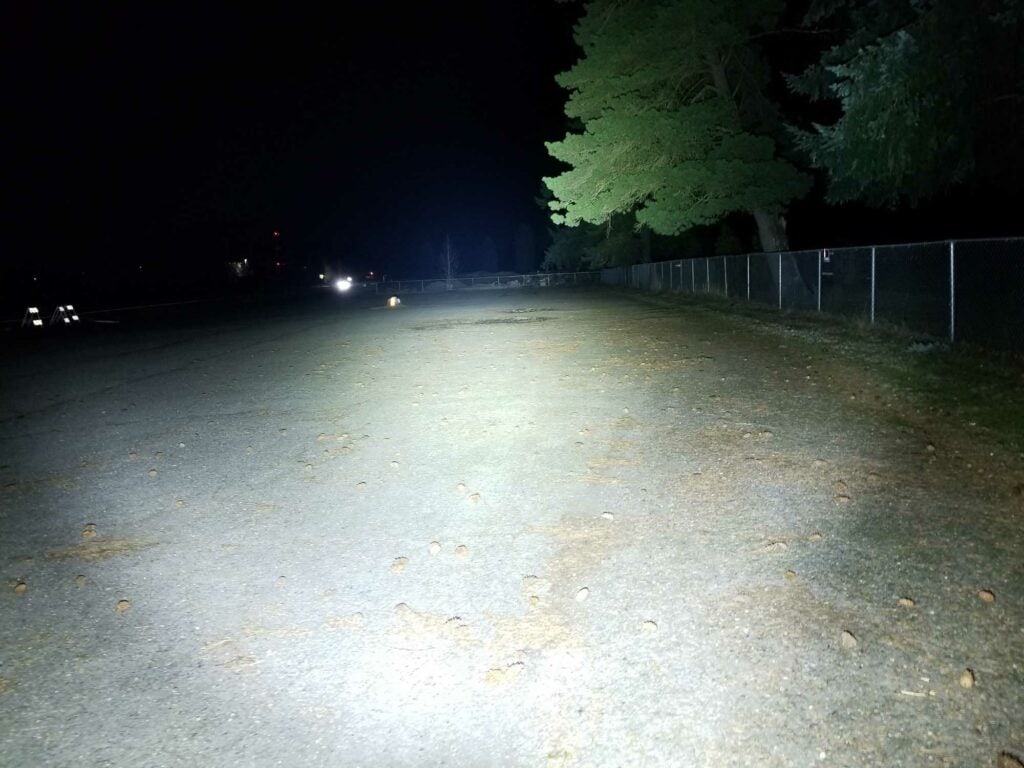
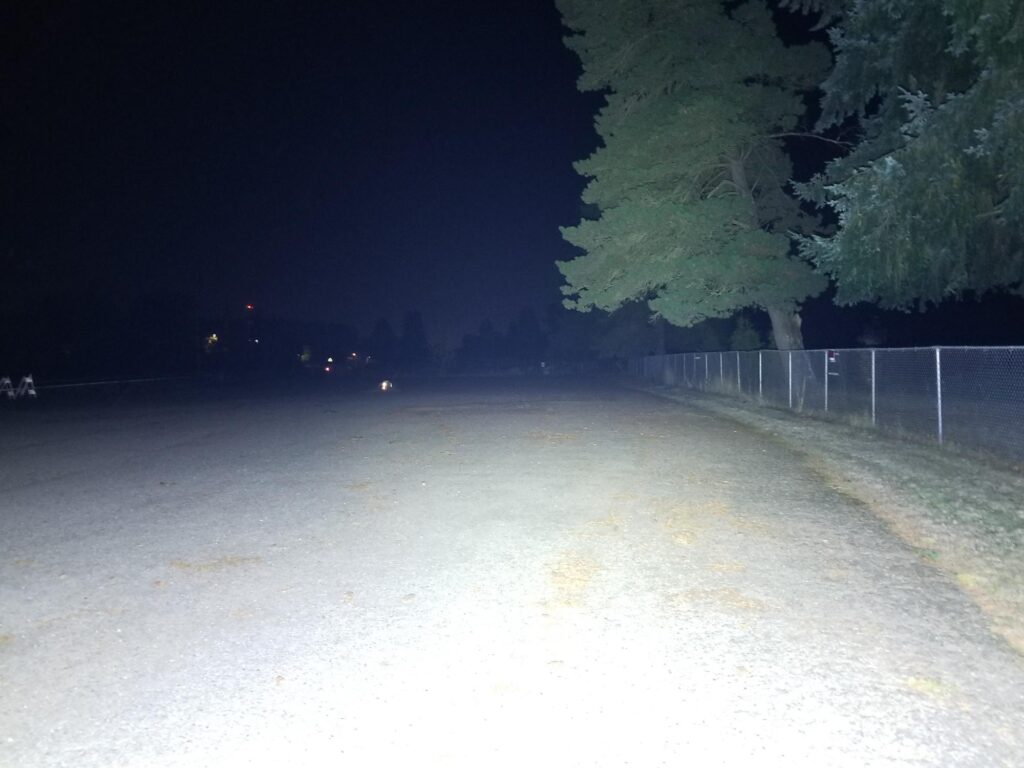
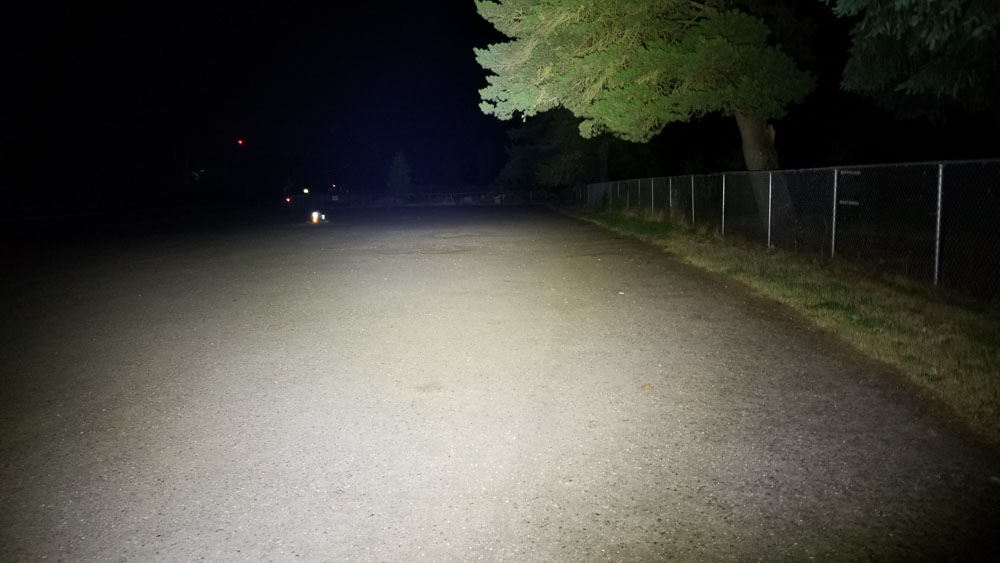
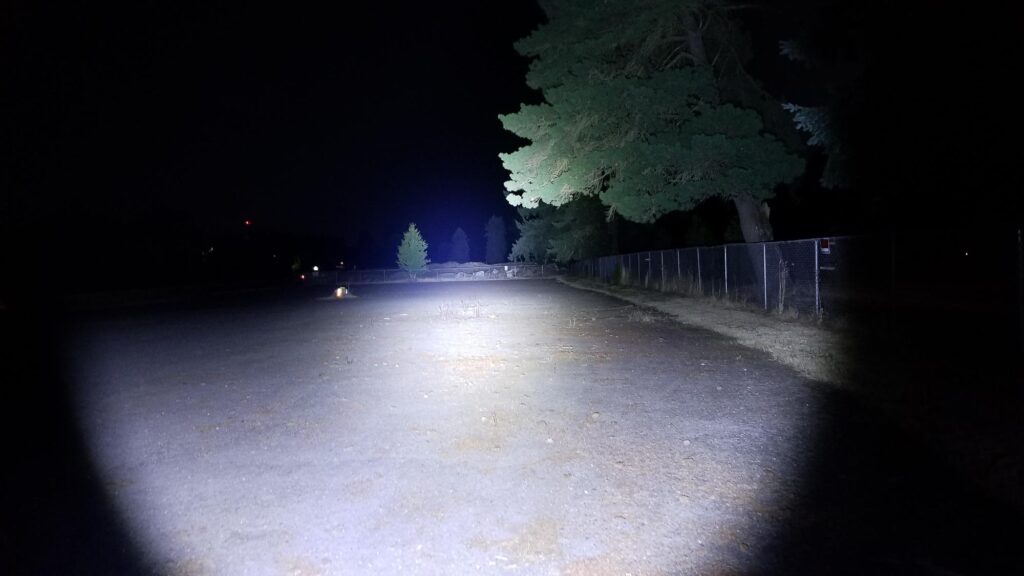
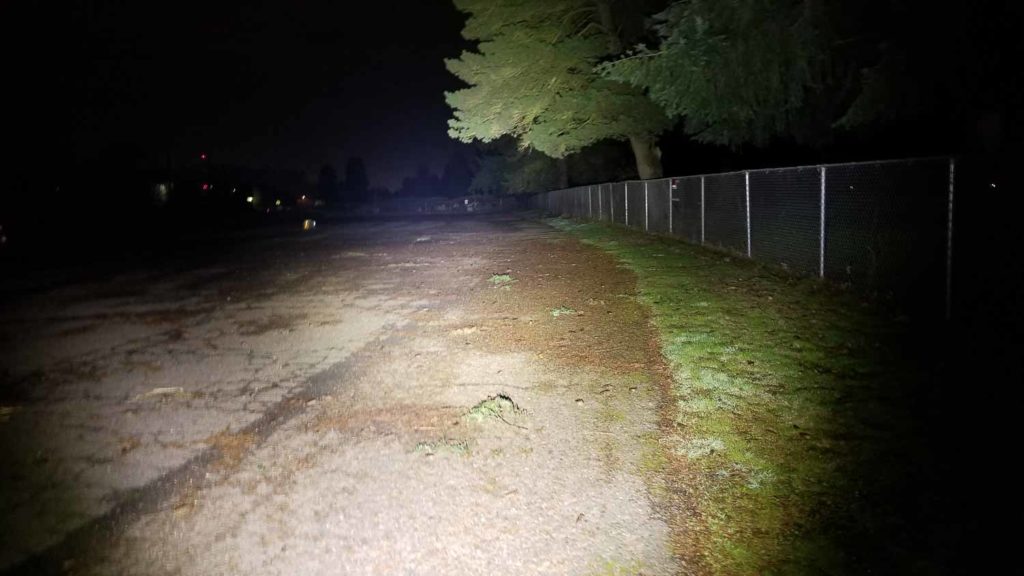
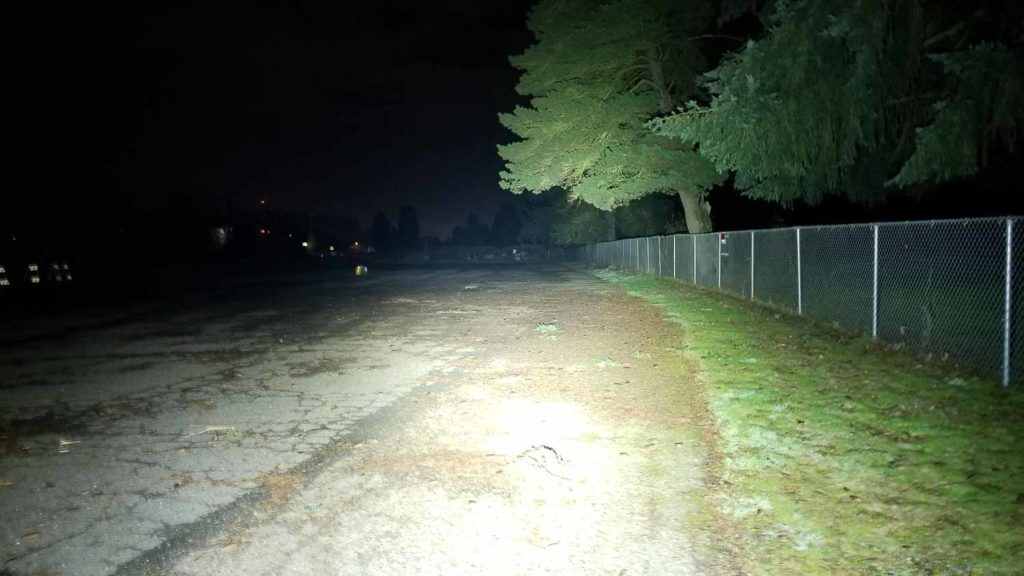
Disclaimer: This flashlight was sent to me for review at no cost by Speras. I have not been paid to review, nor have I been holding back on problems or defects.
Final Verdict
Pros
- Awesome build quality
- Great handling
- Extremely versatile and functional dual switch UI
- Onboard charging
- Great sustained output with honest performance specs
- Doesn’t get too hot
Cons
- Thermal regulation needs work
- Missing a spring on the driver
- I didn’t see the 5 volt 3 amp charging speed
Explanation on star ratings:
1: Avoid: a match would be a better choice – 2: Poor: significant defect or issues; almost unusable – 3: Average: some defects or issues; but still usable 4: Good: recommended (minor issues) – 5: Great: highly recommended

4 stars: ★★★★
As far as multiple LED lights these days, it’s sort of a mixed bag and generally they’re lumped into one of two camps. On one side you get enthusiast-centric lights with crazy, but poor sustained output, impractical, complicated user interfaces, and direct drivers.
On the other, you see lights like the Speras P10R V2, which can achieve sustained high output, a simple practical user interface, and great build quality that’s going to be reliable and function under duress. Plus, they come with great warranties. The Speras P10R V2 didn’t disappoint in those areas, and I think this light makes an argument for professional-use multi LED lights that would work good in the field. It handles nice, the dual switch UI is very practical and versatile, and I enjoyed having instant Turbo mode as well as easy access to the Eco mode. You get really good reach out of the beam as well. There’s a few things I felt were a bit out of place on a $200 light though, namely the unrefined thermal regulation on Turbo and High mode.
Instead of a nice, laminar output, the familiar sawtooth zig-zag thermal regulation is present here and it’s a bit of a let down since it results in noticeable dimming of the output during use. It is not terrible like I’ve seen on some cheaper lights, but it’s noticeable and shouldn’t be seen on an expensive light. The missing spring on the driver is also an important part that’s missing here, and it’s pretty much mandatory on lights going into the field. Lastly, Speras says the light can do 5 volt 3 amp charging, but I didn’t see it, even on a depleted battery on a 45W PD power brick capable of that output with a type C to type C cable. Maybe a fluke?
Even with the strikes, this is a good light from Speras, and I give them major props for fielding a functional, practical 3x LED high output 2×21700 light that would be happy surveying a property line at night or search and rescue duties. 4 stars for the P10R V2.
Buy your Speras P10R v2
1lumen selects and reviews products personally. We may earn affiliate commissions through our links, which help support our testing.